

SPRAY UNITS

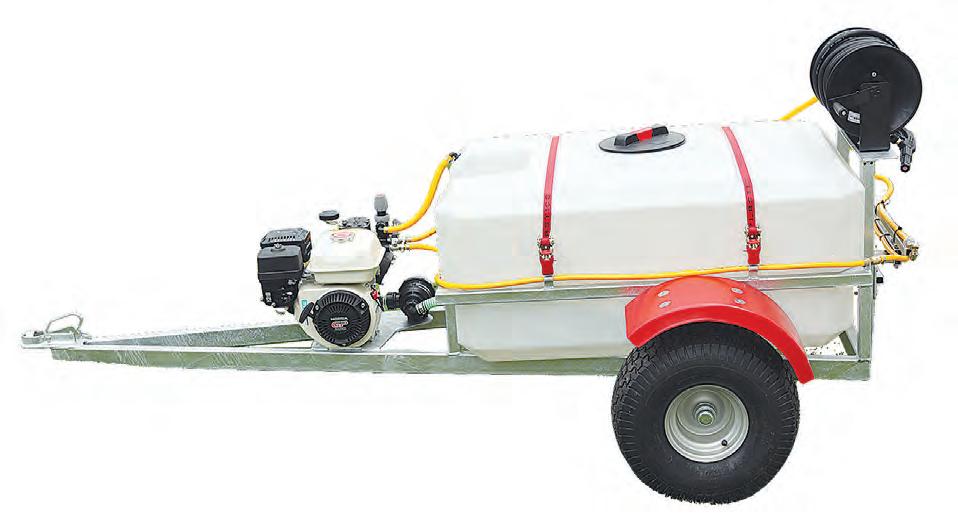


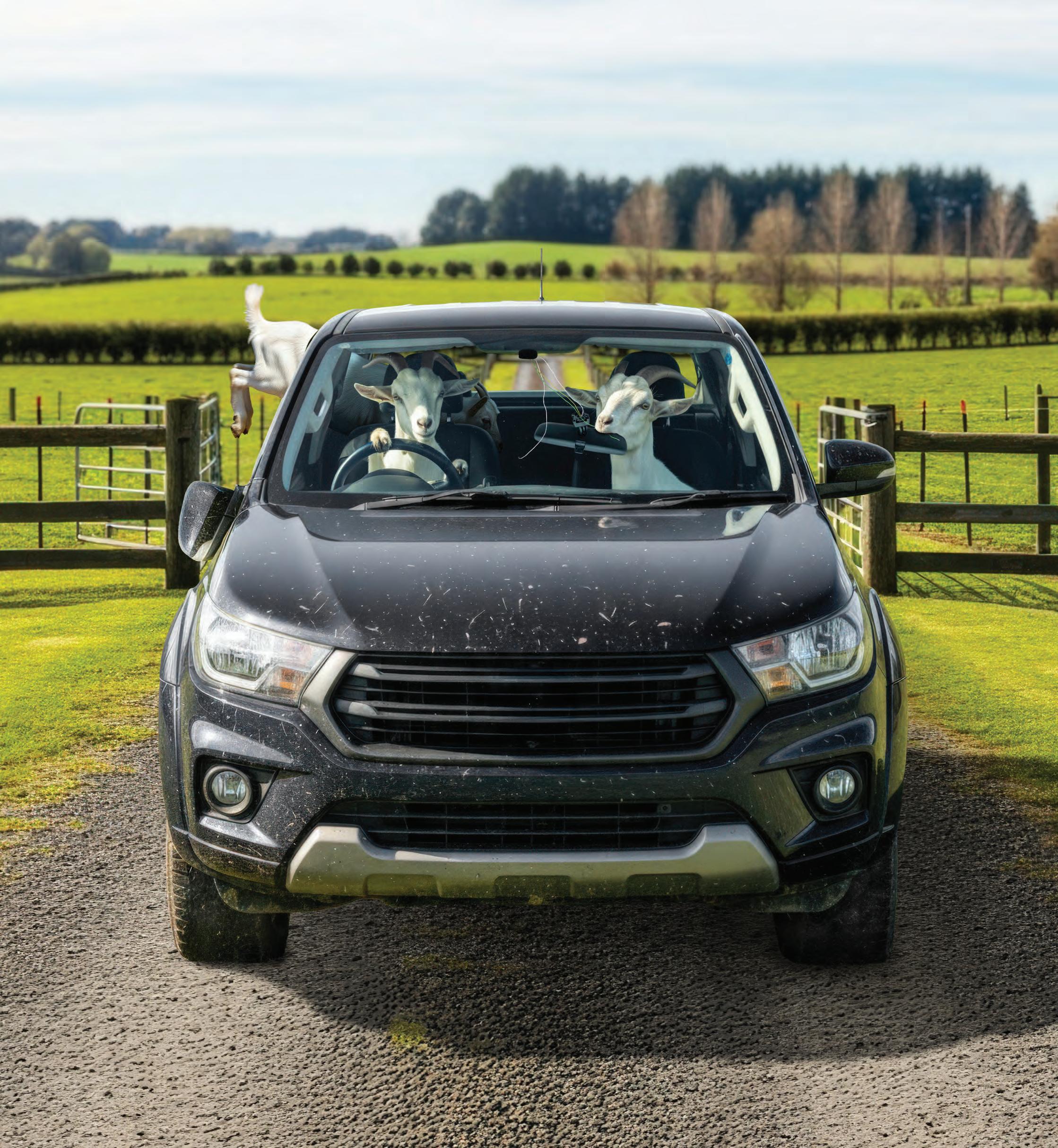
Galvanised
YOUR FMG RURAL CRIME PREVENTION CHECKLIST.
To help avoid crime on your rural property (like keeping your stock where they’re supposed to be) use this handy checklist. At FMG, we’ve seen it can make a real difference.
LIVESTOCK
Do regular stock counts.
Fix any fence issues promptly.
Communicate with neighbours and police about suspicious activities.
BUILDINGS
Lock external doors to buildings and ensure windows are maintained and secure.
Regularly secure sheds, storage areas, and outbuildings.
Keep keys for buildings and equipment out of sight.
WHILE AWAY
Have someone check on the property.
Use timers for lights or radios to make it look like someone is around.
We’re here for the good of the country.
PERIMETER VISIBILITY
Ensure your RAPID number is clearly visible. Check that fences and gates are in good condition and secure. Trim trees and bushes to reduce hiding spots for offenders.
YOUR RURAL COMMUNITY
Exchange phone numbers with neighbours and discuss how you can alert and assist each other.
Join or start a Neighbourhood Support group.



Fresh hope for wool
WOOL FARMERS are hoping that efforts by two leading companies to develop a more efficient supply chain would eventually boost farmgate returns.
Wools of New Zealand and PGG Wrightson (PGW) are looking at sharing wool logistics operations. The companies say the discussions are in response to the over-capacity across New Zealand’s wool logistics infrastructure, following a long-term decline in production volumes that has driven up operating costs.
Federated Farmers meat and wool chair Richard Dawkins told Rural News that a move towards a more efficient supply chain is worth celebrating.
“With that in mind, this announcement is a discussion about efficiencies in a declining sector and controlling costs.
“Ideally, we would be celebrating market-driven premiums, profitability across the supply chain and subsequent returns to the farmer.”
By working together, Wools of NZ and PGW aim to reduce costs, improve asset utilisation and help secure a stronger future for wool growers and the sector. Continuing to support a large, under-utilised infrastructure is becoming sustainable for wool

companies, some of which are owned by farmers.
Wools of NZ chief executive John McWhirter says as a 100% farmerowned company, growers expect us to be proactive in leading change that supports a strong future for New Zealand wool.
“Coming together to seek solutions is an important step towards a more
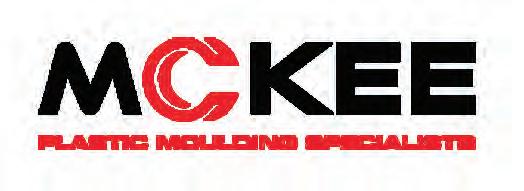
sustainable and competitive future for New Zealand’s wool sector, a key contributor to the country’s economy.”
PGG Wrightson Wool general manager Rachel Shearer says the discussions make sense at a time when the wool supply chain is under pressure, illustrating their continued faith in the fibre and its future.
“Farmers are facing rising costs,
and like them, we must control our costs too. This joint approach represents a practical example of industry leadership to discuss how to reduce duplication, improve efficiency and ensure the infrastructure that remains is fit for the future.”
Dawkins agrees. With fewer halfempty wool stores, and better wool handling, the whole system becomes
more efficient and cost-effective, he says.
“In turn, this should improve returns to the grower.
“Hopefully these cost savings can also be invested to realise higher value end uses and further supply chain efficiencies. To progress as a sector, a combination of corporate and farmer profitability is essential.”
Dawkins says it’s up to individual companies to join Wools of NZ and PGW and depends on their business structure and strategy.
“Having too many large, inefficient stores is a significant cost, and this is one way for companies to reduce that negative impact. Smaller businesses may not have those overheads.”
Both Wools of NZ and PGW will continue to independently operate and compete for wool, ensuring farmers retain full choice over who they choose to transact their wool with.
After years of poor returns, the wool sector is going through some positive changes.
“We are seeing some new ideas and collaboration, which is exciting to see,” says Dawkins.
“Recent improved returns have been a real boost for farmers, although a concern is that it could be driven by declining supply, rather than a significant shift in the market or supply chain.”





Wools of New Zealand chief executive John McWhirter and PGG Wrightson wool general manager Rachel Shearer.
You could get business from the farm to a billboard with $1 deals YOUR Talk to one of our business experts in-store today.



Fonterra farmers approve $4.22b divestment plan
SUDESH KISSUN
sudeshk@ruralnews.co.nz
1-9
10
10
10-11
12-13
14
HEALTH 15
16-17
AND
Inkwise NZ Ltd
CONTACTS
Editorial: editor@ruralnews.co.nz
Advertising material: beckyw@ruralnews.co.nz
Rural News online: www.ruralnews.co.nz
Subscriptions: subsrndn@ruralnews.co.nz
18-22
24
ONE OF Fonterra’s largest milk suppliers says Fonterra board and management have got what they had wanted – a great turnout and a positive signal from shareholders on the sale of its co-operative’s consumer and related business.
The $4.22 billion sale to French dairy giant Lactalis got the nod of 88.47% voters at a special general meeting held online last week.
State farmer Pamu voted in favour of the sale.
Pamu chief executive Mark Leslie told Rural News it was good to hear that shareholders had delivered a strong ‘yes’ vote.
Leslie says it’s also good to see how Fonterra is investing in its food service and ingredients businesses including investments at plants in Edendale and Clandeboye in the South Island.
“It’s great to hear the outcome and also how the co-operative is investing in the future of its business.”
Fonterra chair Peter McBride says the board and management team were encouraged by the level of engagement from shareholders in the lead up to the vote.
“We’ve been pleased to see so many farmers joining in the discussions since the start of this process in May last year when we first announced the decision to explore divestment options, and especially over the past month or so when the full details have been available,” says McBride.
“It helps to demonstrate one of the key things that sets us apart from most other processors – our farmers have a direct say in the future of their co-operative, and they’ve made the most of that opportunity.
“We’re pleased to have received

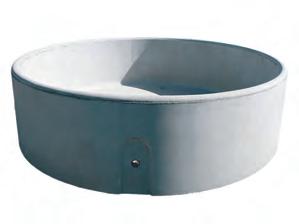
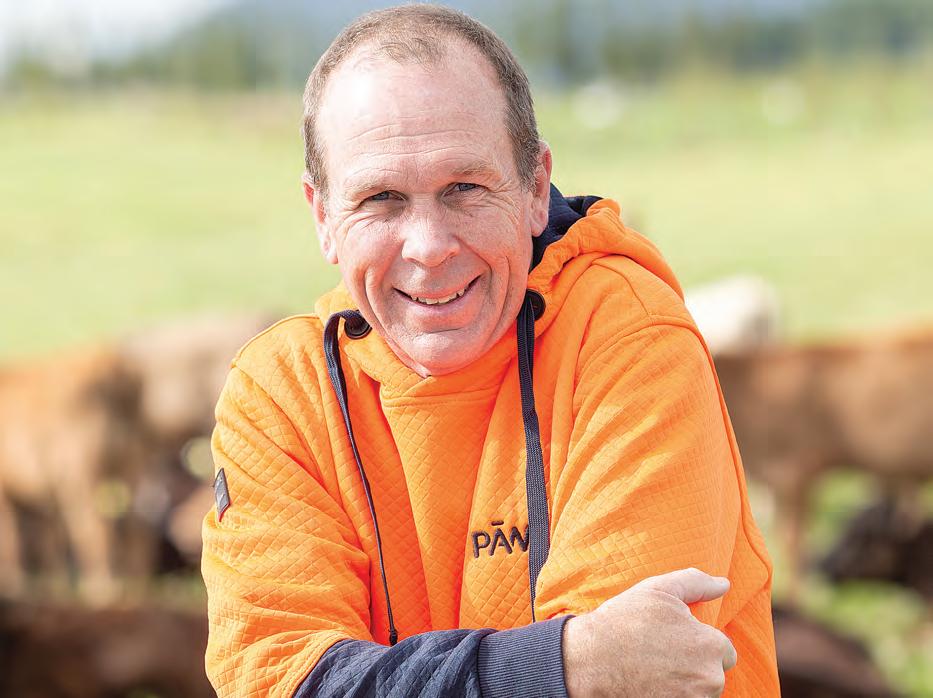
a strong mandate, with 88.47% of the total farmer votes cast in support of the recommendation and 80.59% participation based on milk solids voted. We want to thank all farmer shareholders who voted.”
McBride says the decision to divest the Mainland Group businesses is significant and one the board did
NEW VOTE
FONTERRA IS targeting a tax-free capital return of $2 per share to shareholders and unit holders, equivalent to $3.2 billion, once the sale is complete.
Another shareholder vote will be required for the payment of the
not take lightly.
“We have examined the strategic context we operate in, our strengths and how as a Co-op we create value for our farmer owners.
“The divestment will usher in an exciting new phase for the co-op. We will be able to focus Fonterra’s energy and efforts on where we do our best
return. The process for that capital return is expected to be by way of a scheme of arrangement under Part 15 of the Companies Act 1993. The Co-op plans to provide more detail on the timing and process for the capital return in early December.

work. We will have a simplified and more focused business, the value of which cannot be overstated,” says McBride.
The threshold required to approve the sale was for more than 50% of the votes from those entitled to vote (based on share-backed kgMS) and who actually voted to be in favour of the proposal.
Completion of the divestment remains subject to securing certain regulatory approvals and the separation of Mainland Group business from Fonterra, both of which are well underway.
Subject to these steps being completed, Fonterra expects the transaction to complete in the first half of the 2026 calendar year.
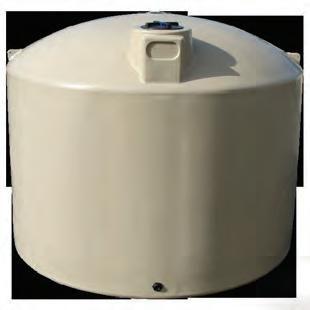

Stainless steel bracket and Shaft • Fits plastic and concrete tanks • Rugged and long lasting

Pamu chief executive Mark Leslie says the state farmer voted in favour of Fonterra divesting its consumer and related businesses.
Wind, snow wreak havoc
A
RARE weather doublewhammy has seen many South Island farmers having to deal with unseasonal snow while still cut off from power supplies after an unprecedented windstorm.
The wind struck on the Thursday before Labour weekend, ripping across Clutha and Southland and many parts of Canterbury, destroying farm buildings, bringing down trees and power lines and toppling irrigators.
Then a cold snap came through at the end of Labour Weekend with snow closing alpine highways and falling to sea level in some areas.
Southland mayor Rob Scott told Radio New Zealand the ferocity of the windstorm had taken everyone by surprise.
Four days on, there were still many farm properties across
Southland and Clutha without power and states of local emergency were still in force.
Kass Rauber, Federated Farmers
Southland vice-president, said that while Southland wasn’t getting the worst of the snow when the cold snap came though, it was bitterly cold.
Rauber told Rural News it was very hard on people who were then approaching 120 hours without mains power.
“These people living on the generator at their houses, they might have running water with the power to the pump, they’ll have some lights in the house and they can run the toaster and the jug, they might just be able to run the microwave.
“But these people haven’t got the hardwired stuff. They haven’t got an oven. They haven’t got a hot water cylinder that’s going, they haven’t got heat pumps going. So
that will become more difficult.”
Rauber said almost all dairy sheds cut off from the network were running on generators and the roads were open.
Quite a lot of farms suffered damage from trees falling on to sheds with equipment and the likes parked in them.
“There’s the odd tree across the road here and there, but the biggest thing was power lines on the road. But within 24 hours, those power guys have done a fantastic job and cleared most of those lines, roads are open again, tankers are getting around and getting the milk out.”
He said the lines companies were doing a fantastic job, but they had to start with the biggest lines and work down, and some of the very small lines to individual properties hadn’t been fully assessed yet.
“There’s a lot of damage out there.”
“I have to say they have worked day and night getting poles back up, getting wires back up, getting contractors into clear trees off power lines and power poles. That’s worked very efficiently and very well.”
Speaking from the Balclutha emergency management centre, Associate Agriculture Minister Mark Patterson said the snow was adding insult to injury but he hoped it would come and go quickly as more normal spring weather returned.
While lambing would be over for most, there would still be some lambs being born in higher country.
Patterson said the bigger problem was still assessing and restoring the power network, with about 8000 homes across Clutha and Southland still without power, although many would have access to generators. Power companies
NEW VC FOR MASSEY UNIVERSITY
PETER BURKE
peterb@ruralnews.co.nz
THE HEAD of Fonterra’s R&D facility in Palmerston North is set to literally cross the road and become the new vice chancellor at Massey University.
Professor Pierre Venter takes up his new role next February, replacing Professor Jan Thomas who has been the VC at the university since 2017.
Venter was born and educated
in South Africa where he was a researcher and later professor at the Central University of Technology in the Free State. He holds a PhD in Microbiology.
In 2011 he came to Fonterra and held several senior science roles, all based at the company’s R&D Centre in Palmerston North. In 2019 he was appointed as GM of Innovation Services and in 2023 became the director of the facility which is focused on developing what he calls

were working overtime with crews coming in from all around the South Island to help.
“There is just a lot of trees down on those lines,” said Patterson.
“We deployed the defence force to get generators down here on a Hercules, and soldiers deployed to go up driveways basically, and get to farmers who were without power and communication to just get some information to them and gather
the “next generation dairy solutions”. Massey Chancellor Alistair Davis says Venter’s appointment marks a significant milestone for the university. He says his leadership, strategic insight, and commitment to innovation and inclusion will be instrumental in strengthening its impact both locally and globally. He says Venter’s experience of both academia and applying research into the commercial world will bring a fresh lens to this sector-wide
challenge.
information to bring back into the emergency management.”
The aircraft were also bringing transformers and other electrical equipment for repairs to the lines network.
“This is a big event and there’s people everywhere that are terribly impacted. So, the snow just compounds their misery. But there’s an incredible network of people, volunteers and lines company, water, and telecommunication
“With Professor Venter coming from NZ’s largest exporter, and an organisation deeply embedded in the agricultural sector, Massey is reinforcing its highly regarded reputation as an applied university at the heart of Aotearoa New Zealand’s economy,” he says.
Venter says what drew him to Massey was its proud heritage, clear sense of purpose, and global reach and says it plays a vital role in in
workers working overtime to get those services back up and running. But the widespread nature of the impact is just stretching everyone’s resources.”
Patterson said his own farm, at Lawrence, also suffered damage.
“A couple of sheds, and trees down everywhere but there’s nothing unusual. That’s just like everyone else really. There’s very few farms that got through unscathed.”
areas that matter most to NZ.
“I see enormous potential to strengthen Massey’s leadership position both here and globally, to further modernise how it delivers education, and to build new partnerships with industry and government. Massey has the scale and capability to lead the next generation of universities, and I’m excited to work with staff, students, and Council to bring that vision to life,” he says.

Fallen trees over a road and powerlines near Gore.
PHOTO: GORE DISTRICT COUNCIL/FACEBOOK
Bank supports aspiring dairy farmers
MID-CANTERBURY MAN WINS CFMOTO UTV!
BNZ SAYS its new initiative, helping make the first step to farm ownership or sharemilking a little easier, is being well received by customers and rural professionals.
The First Farm proposition helps lower barriers to entry for first-farm buyers or those buying their first dairy herd by reducing deposit requirements. It also pairs every approved customer with an experienced farmer mentor for their first two seasons.
BNZ general manager agribusiness and corporate banking Dave Handley says this will help ensure their first steps into farm ownership or sharemilking are a success.
Handley told Rural News that initial feedback has been positive.
“All parties acknowledge how hard

it can be for quality operators to save to get in a position to buy their first herd or farm, this offering helps bridge that gap but importantly, wrapping the support around them of a proven operator who know what it takes to succeed long term,” says Handley. First Farm matches mentors and mentees by region and experience, provides toolkits and discussion guides, and check-ins at key milestones so the relationship gets the
attention it deserves.
Handley says for many young farmers, getting their first foothold on the farming ladder is very challenging.
“First Farm is about bridging that gap by making ownership more achievable.
“And this isn’t only about finance. Every farming customer participating in our First Farm programme will be matched with an experienced farmer mentor who has been through the highs and
lows of herd or farm ownership and knows what it takes to make a farming business succeed.
“Every mentor-mentee relationship will be slightly different. But the one-on-one support from a proven operator in key areas such as business planning, budgeting, cashflow, governance, and people decisions will make a real difference from day one. Having someone in their corner with that hard-won experience, generously shared, will really make a difference for our industry participants.”
The bank is expecting uptake will be strong. Interest from young farmers is also strong.
“We have seen that younger farmers have been thirsty for knowledge and have a desire to build their networks: all in the efforts of progressing through the farming ranks. We think this package will have

We have a winner! The Rural News Group-CFMOTO UTV giveaway has attracted thousands of entries. Thanks to everyone who took the time to participate. The first name out of the hat was Ian Maw, an arable farmer from Mid Canterbury, near Methven. He will soon be picking up a brand new CFMOTO UFORCE 600 EPS FARM SPEC – a tough workhorse valued at over $20,000 and built for real work, not weekend posing. It comes with a tilt windshield, rear poly screen, roof kit, half doors, front protection bar, a 3500lb winch and much more.
real appeal.”
Handley says the bank’s agri partners around the country are talking to younger farmers every day on what the next step in their farming journey looks like as well as helping plan the path to getting there.
First Farm is available across the country
to eligible first-time dairy farm buyers and those purchasing their first dairy herd for sharemilking. While initially focused on dairy, BNZ plans to offer similar initiatives to other agricultural sectors in the future.
Handley says they hope to extend the offering to other agri
POSITIVE VIBE
DAVE HANDLEY says most of the agri sector is in really good shape and mood and sentiment has come a very long way over the last 12 months.
sectors soon.
“We want to make sure we bed down the dairy programme first and take the lessons we learn from that and adopt them for future iterations.
“With each industry within the NZ Agri sector having its own characteristics, we can’t just roll out a ‘one size fits all’.”
“We have seen a lot of farmers over the last 12 months direct cash to repaying debt in order to make their business more financially resilient, however we have now seen a shift with our clients looking at expansion opportunities or investing back on farm in infrastructure or technology,” he told Rural News.
“History tells us that when are farmers are looking to do these sorts of transactions, the feeling both on farm and about the industry they are in is really positive.”

BNZ general manager agribusiness and corporate banking Dave Handley.
Keeping pace with biosecurity risks
THE HEAD of the Ministry for Primary Industries (MPI) biosecurity operation, Stuart Anderson, has defended the cost and the need for a Plant Health and Environment Laboratory (PHEL) being built in Auckland.
He says claims in another farming publication that the new facility is a white elephant are untrue and seem to miss the point about the need for NZ to have a quality laboratory to protect the primary sector.
Anderson says the present facility, based at Tamaki, is at the end of its life and is no longer fit for purpose.
“We now need a facility that will serve us for the next 50 years,” he told Rural News
Anderson says the MPI laboratory, which has about 60 staff, carries out a several functions including diagnostic, inspection analysis, diagnosis of plant pests, diseases and viruses and supports MPI’s surveillance programmes. He says it deals with issues such as the recent fruit fly incursion and helps provide trade assurances of our ‘pest-free status’ for exports. He says it also has a quarantine facility which insures the safe importation of new plant material for the horticulture sector.
“The cost of the quarantine component of the new laboratory has attracted some criticism, but the fact is that this only accounts for about 10% of the total cost.

All those other functions that the lab provides, such as surveillance responses and trade, are by far a bigger part of the cost of the facility,” he says.
The new MPI laboratory is being built on what is widely known as and Plant and Food Research’s campus at Mt Albert in Auckland and Anderson says co-locating on this site makes sense. He says it means that scientists from both organisations will be able to collaborate and potentially share facilities as and when appropriate. He says the new lab will feature new innovative technologies.
“This gives both of us a strategic advantage and creates a centre of science excellence. It is possible that other science organisations may also locate here in the future,” he says.
@rural_news facebook.com/ruralnews
THE AUCKLAND FACTOR
THE SITING of the Plant Health and Environment Laboratory (PHEL) in Auckland is logical because that city is a major entry point for imports of plant material and its airport is the major gateway into NZ where the biosecurity risk is arguably higher.
It acts as a hub, being close to the Bay of Plenty and Northland.
Having a new and modern biosecurity facility in Auckland also helps build resilience into MPI’s overall response capability,
says Ministry for Primary Industries (MPI) head of biosecurity operation, Stuart Anderson. It already has a quality animal health laboratory at Wallaceville near Upper Hutt.
“The new PHEL at Mt Albert will have containment laboratories and facilities built into it which are the equivalent to that of Wallaceville,” he says.
“In the worst-case scenario of say a foot and mouth disease outbreak this plant lab would be able to handle an animal

response of this kind of scale as well. So it provides that sort of resilience as well for biosecurity more broadly.”
NZ is very fortunate, he says, in that it doesn’t have the large numbers of pests that other countries have.
This is because our biosecurity settings are more stringent than others and we have more to lose given that our primary exports are the mainstay economically of our country.
He says with modern communications the world
has become smaller and is changing from a biosecurity perspective and so NZ must be more vigilant.
Anderson says things like climate change start to come into play, trade patterns are also changing and there are different supply chain demands.
“Taking all this into account we need to keep ahead of those everincreasing risks and one way of doing this is to have a modern high quality science facility to deal with this,” he says.
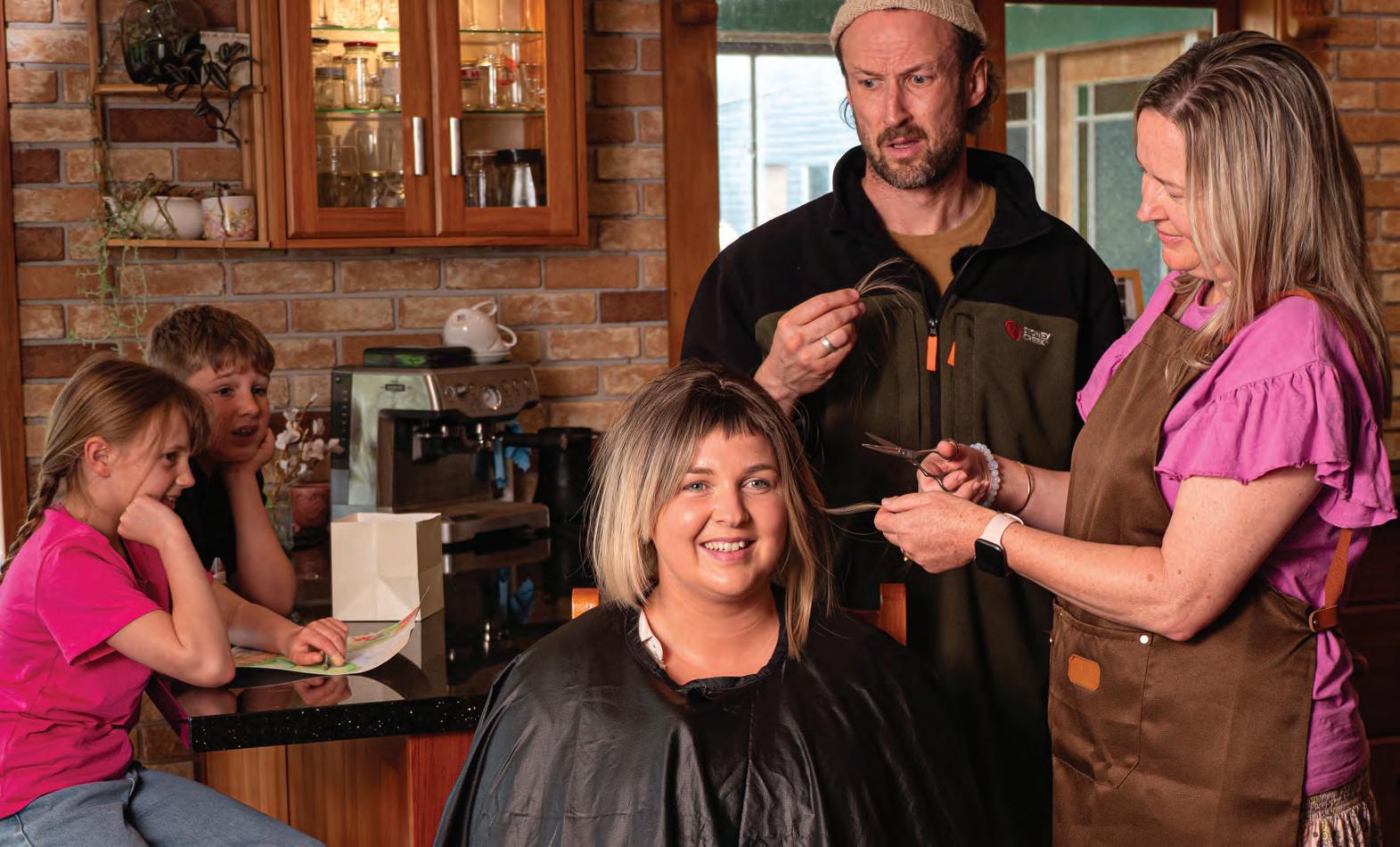
MPI’s Stuart Anderson (inset) says a quality laboratory in Auckland is needed to protect the primary sector. PETER
No plant closures
SUDESH KISSUN
sudeshk@ruralnews.co.nz
THE NEW majority owner of meat company Alliance has no plans to close any processing plants. Instead, Dawn Meats plans to extract more value from Alliance’s existing footprint.
Dawn Meats chief executive Niall Browne told Rural News that Dawn Meats conducted comprehensive due diligence on Alliance’s plant network as part of the process.
“Following the difficult but necessary decision to close the Smithfield plant in Timaru, we’re confident Alliance’s processing capacity is well balanced with livestock flows. We have no plans for plant closures,” Browne says.
“Alliance has returned to profitability after two very tough years. We aim to build on this profitability through our expertise in resource efficiency, especially around water, energy and yield optimisation. We believe we can extract more value from the existing footprint.
“The best way to be competitive at the farmgate is to run an efficient, profitable business that’s connected to premium global markets, and that’s exactly what this partnership enables.”
Over 87% of Alliance farmer-shareholders voted in favour of Dawn Meats’ $270 million investment.
One of Europe’s leading red meat processors, Dawn Meats will acquire a 65% shareholding in
Alliance Group, with farmer-shareholders retaining a 35% stake.
The deal is moving through the final regulatory and legal steps.
The new joint venture should be up and running next month. Dawn Meats will have three directors on the new board, with two appointed by Alliance.
Browne, who was in New Zealand last month, is encouraged by the positive reception from farmers to the outcome of the vote.
“I had constructive discussions with a range of farmers while in New Zealand. The farmers I spoke to are excited about the future and the opportunities this partnership with Alliance will unlock,” he says.
Feedback from Dawn
Meats’ global customers has also been very positive.
“We’ve had very positive feedback from customers at major international trade fairs like Anuga in Germany,” says Browne.
“They value New Zealand product and are already asking about year-round supply arrangements. That’s new business that Alliance will now be able to access through Dawn’s extensive European and UK sales network.
“Those higher-value, longer-term relationships give us the confidence and capability to pay competitive livestock prices while maintaining profitability.”
Browne acknowledged the farmgate competition in New Zealand among
meat processors, but he adds that Dawn Meats isn’t fazed.
“Dawn didn’t get to where it is today by not being competitive with livestock pricing.
“Our success has been built on efficiency, strong customer relationships and paying farmers fairly for quality livestock. That same philosophy will apply in New Zealand.”
While in NZ, Browne also attended the inaugural European Union/New Zealand Business Summit in Auckland.
In a panel discussion, he described the joint venture as a big deal for both companies.
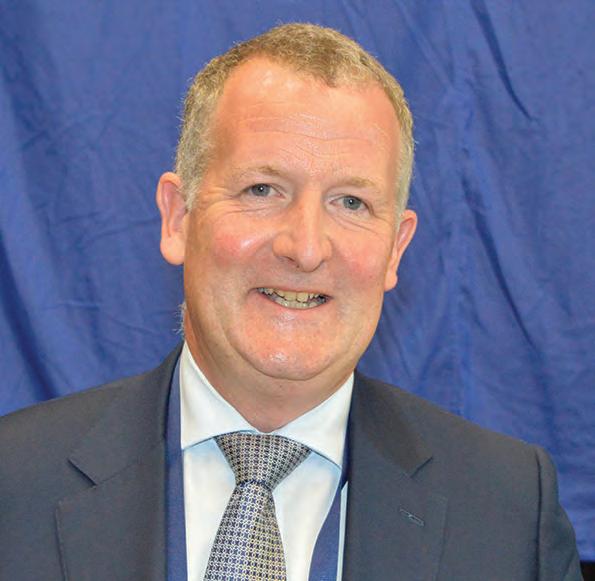
He pointed out that Dawn Meats is a large packer of Alliancesupplied New Zealand lamb in the UK retail space.
“We appreciated the top quality of their grass-fed beef, lamb and venison, and the integrity of the business.
“And, so when the opportunity came up to partner, there was no decision to make, it was a no-brainer.
“They have the same values as us, we appreciate the quality of their products, the long-term relationships with their farmer base –they’re all key ingredients to success.”
The deal also gives Dawn Meats a stronger foothold in the global sheepmeat trade.
Dawn Meats specialises more in beef and is big in the UK and Europe. Browne says Alliance are “experts in lamb” and have great markets in North America and Asia.
“So, when you combine those two elements together, you’ve got the recipe for success.”





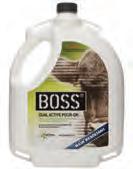



Dawn Meats chief executive Niall Browne.
Red tape frustrates farmers, growers
A MOVE is underway
to make the Wellington bureaucracy speed up the approval process for certain agrichemicals that farmers and growers are desperate to get their hands on.
Dr Liz Shackleton, chief executive of the Animal and Plant Health NZ (APHANZ), formerly known as AGCARM, says

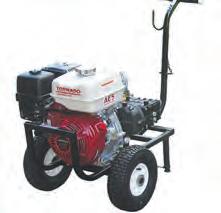
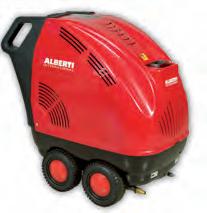


the delays in approving new products means that NZ producers are at a disadvantage to overseas competitors who have access to these products. She says while reform of the





Agricultural Compounds and Veterinary Medicines Group (ACVM) and HSNO Acts is underway and a new parliamentary bill is in the process of being finalised to do this, her members want action now.
The Ministry of Regulation did a review in February into the ACVM and the Environmental Protection Agency (EPA).
Shackleton says they found across the regulatory system there were inefficiencies and delays, a lack of strategic direction, uncertainty and disproportionate regulation. She says they also found there were concerns around resourcing, engagement, industry funding and a breakdown in trust and confidence in the system.
As a result of this cabinet became involved and set out a roadmap designed to speed up the
process so that farmers and growers can have access to the same new chemicals that their counterparts overseas do.
“For example, wine growers in Canada and Australia have been using a new insecticide to deal with mealy bugs. The company that produces this product lodged an application in NZ to get this approved in 2019 and it is ‘still in the system’. Another example is that potato growers in Pukekohe want to use a new chemical to deal with thrips and blight which is more environmentally friendly and has less impacts than present products, but that has still not been approved,” she says.
Shackleton says farmers are also in trouble because a product that is used to control grass grub is still locked up in the system
BLUEPRINT FOR CHANGE
LIZ SHACKLETON says they don’t want short cuts, because the law already exists to do what is required. She says they have launched a simple blueprint which asks for a special taskforce to clear up the backlog of applications for the tools that farmers and growers need most – such as new ingredients and new label uses. She says they want

and notes that the cost to NZ of grass grub alone can be as high as $800 million annually.
In May the EPA’s CEO claimed on the organisations website that the EPA supported the changes and that applications were a top priority. But Shackleton says all the talk hasn’t translated into action.
greater use of international harmonisation and trusted data to streamline approvals and meaningful engagement to co-design workable riskbased decisions.
According to Shackleton, perfectly good solutions are already available and in use overseas. But she says the companies that produce them are becoming frustrated with the red tape
“What farmers and growers are telling us is that they are seeing no sign of any change and are deeply frustrated. Some Pukekohe potato growers are considering their future because they have run out of tools to deal with the problems they are facing,” she says.
in NZ, She notes that one company has already pulled out of dealing with NZ and there is a risk others may do the same.
“Every delay adds stress, cost and risk to our farmers and growers who are trying to do the right thing – grow healthy food, protect the environment and meet rising standards. We need to move from promises to progress.”
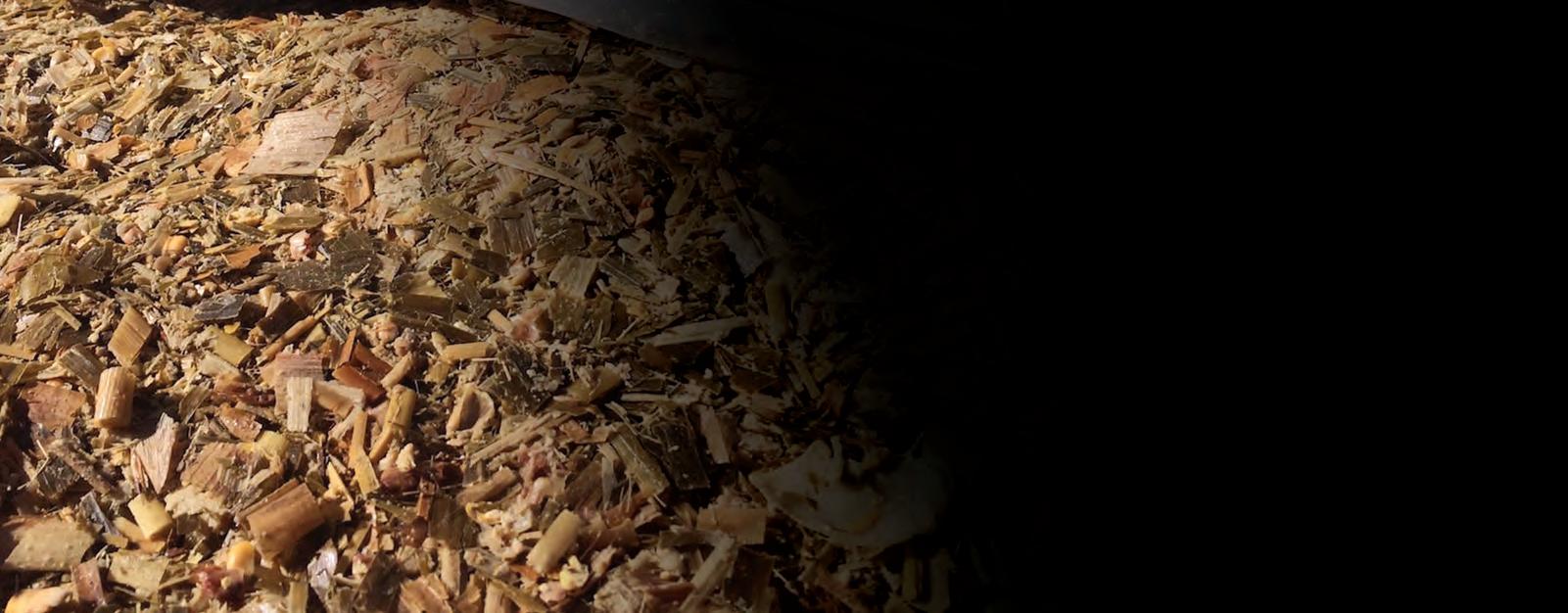
• 24% more protein than untreated silage
• Faster pH reduction, minimising feed value losses
• Live bacteria for effective fermentation
• Stable silage 24 hours earlier than untreated

Dr Liz Shackleton, chief executive of the Animal and Plant Health NZ.
New target ‘political theatre’
PAIGE WILLS
FARMERS ARE being asked to celebrate a target that changes nothing for the climate, wastes taxpayer money, and ignores real science.
The Government’s new methane target isn’t a victory for farmers — it’s political theatre. Dropping the reduction goal from 24–47% to 14–24% doesn’t solve anything. It’s like being told you had to kick your puppy 20 times, and now they’ve reduced it to 10 — it’s still completely wrong, while the real issue, that livestock methane is not driving warming, is completely ignored.
The truth is simple: this target has almost nothing to do with actual climate change.
The Intergovernmental Panel on Climate Change (IPCC) has confirmed that earlier climate models overstated methane’s warming effect by up to four times. Even the Ministry for the Environment’s own data shows that all humanmade methane from 1850 to 2022 caused just 0.0021°C of warming — about 0.000012°C per year. Yet while the evidence shifts, the Government keeps pretending New Zealand livestock are heating the planet.
In reality, New Zealand’s methane emissions have already fallen — from 38,478 kt CO₂-e in 2017 to 36,751 kt
CO₂-e in 2023 — a 4.5% drop achieved naturally, without new technology or taxpayer subsidies.
The Government’s own Methane Science Review (2024) was meant to clarify how much warming New Zealand’s ruminant emissions actually cause. Yet it failed to do the one thing it was commissioned for — quantify New Zealand’s real warming impact. Without that, every target is based on assumption, not evidence — like setting a speed limit without knowing how fast the car can go. Policy is being built on politics, not physics.
This new target isn’t about protecting the climate, it’s about protecting political credibility. By lowering the bar slightly, the Government can claim progress without admitting the entire premise was wrong.
Meanwhile, more than $400 million of taxpayer money continues to be poured into companies like AgrizeroNZ to fund “solutions” such as methane vaccines, feed additives, and boluses — interventions that are experimental, unnecessary, and in some cases risky.
Even if these tools ever prove feasible, they still miss the point: methane reductions from ruminants will not translate into meaningful climate cooling. Yet these measures threaten the very reputation of
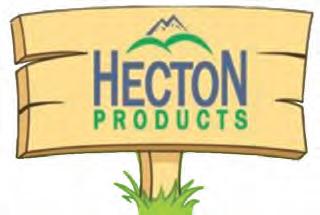
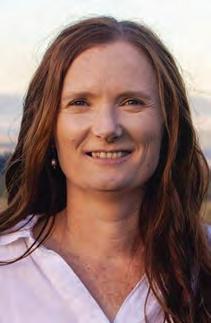
New Zealand farming, long recognised for producing natural, grassfed, minimally treated food. Consumers buy New Zealand products for their purity — not for lab interventions.
Our farmers feed a growing global population with high-quality, natural, safe, emissions-efficient food. That ability is something to protect, not punish. New Zealand farming isn’t the climate problem, it’s part of the climate solution. Our grass-fed, pasture-based systems produce some of the lowest emissions per kilogram of food in the world. Undermining that system with unnecessary interventions erodes our competitive advantage and the trust that underpins New Zealand’s brand.
Public funds could be far better spent supporting essential services and infrastructure. Instead, hundreds of millions are being channelled into methane technologies that neither farmers nor consumers want — and that deliver no
measurable reduction in warming. In a country facing a cost-of-living crisis, a chronic shortage of doctors, nurses, and teachers, and crumbling infrastructure, this is money literally disappearing into the wind — a waste of taxpayer money on a scale that should outrage every New Zealander.
ACT MP and Associate Minister of Agriculture
Andrew Hoggard recently claimed that “with some of the technologies coming online, their use in the dairy industry alone would likely achieve the methane reductions needed over the next 25 years”. That assumes reductions are needed at all, and they’re not.
Hoggard’s statement is wishful thinking at best and deeply misplaced at worst. Methane is part of a natural biological cycle that has remained in balance for millennia. Farmers and consumers alike don’t want to interfere with ruminant digestion just to meet an arbitrary political number.
The only commonsense target for livestock methane is zero. If cutting methane won’t cool the planet even a fraction of a degree, mandating reductions of any size wastes money, erodes trust, and punishes the very people feeding the nation.
Industry bodies Federated Farmers and Beef + Lamb NZ have welcomed the lower
target as a relief, but that endorsement is a capitulation. Beef + Lamb NZ admits farmers will still face a “stretch” to meet the new targets while being expected to make efficiency improvements and “use tools and technologies where it makes sense.” In other words, they’ve accepted incremental change rather than standing firmly for farmers’ rights — despite the latest Groundswell, Methane Science Accord,
and NZ Farming 2025 survey showing 71% of farmers would not adopt any methane-reduction tools, even if readily available.
Before another dollar is spent or another headline claimed, the Government owes New Zealanders an honest answer: what measurable warming are we actually reducing — and at what cost? Good policy starts with good science, not political spin. It’s time to steer New Zealand’s
DRAINAGE AND SOIL AERATION
PAY BIG DIVIDENDS
climate policy back to reality with targets that reflect how the atmosphere actually works. Anything else is political window dressing — and hundreds of millions of dollars being flushed down the drain that could be rebuilding the essential services this country desperately needs.
and
@rural_news

Don’t put good fertiliser on compacted soil which can’t absorb it. If your soil can’t support 15cm root growth and good worm population check for compaction. You could need aeration. In dollar terms, what would 20% production increase mean to your yearly turnover?
YOUR GREATEST ASSET IS THE SOIL YOU FARM. DON’T DESTROY IT!


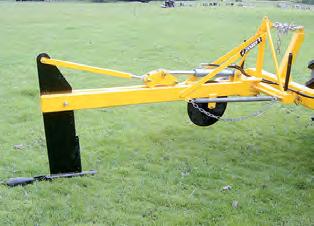
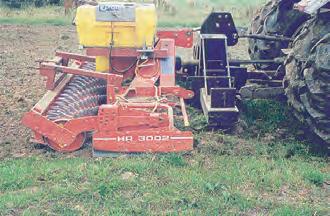


• Paige Wills is a sheep
deer farmer from the Waitaki Valley.
Paige Wills
EDITORIAL
United strategy for wool
WOOL FARMERS believe the future of strong wool still holds promise.
Industry initiatives are underway to unify fragmented efforts to return the industry to its former glory. The Government is also signalling its support.
But for the wool sector to fully recover from its doldrums, farmer engagement is key.
That’s why the recent announcement by leading wool companies Wools of New Zealand and PGG Wrightson to work on improving logistics gives the wool sector new impetus.
As wool traders, both Wools of NZ and PGW have realised that operating half-empty shops is a loss for everyone – traders and farmers.
Wools of NZ, a farmer-owned co-operative, and PGW have decided to look at collaboration to reduce costs, improve asset utilisation and help secure a stronger future for wool growers and the sector.
Their decision to share logistics where appropriate is in response to the overcapacity across New Zealand’s wool logistics infrastructure following a long-term decline in production volumes, which has driven up operating costs. The move comes as the Wool Alliance is announced – wool industry organisations working together to revitalise the strong wool sector.
As Federated Farmers meat and wool chair Richard Dawkins points out, a move towards a more efficient supply chain is worth celebrating.
However, he quickly adds that this announcement is a discussion about efficiencies in a declining sector and controlling costs. Ideally, the sector would be celebrating market driven premiums, profitability across the supply chain and subsequent returns back behind farmgate.
Collaboration between wool means fewer half-empty wool stores, and better wool handling and the whole system becomes more efficient and cost-effective.
Wool farmers are hopeful that this initiative will save costs and improve grower returns.
And these cost savings can also be invested to realise higher value end uses and further supply chain efficiencies.
To progress as a sector, a combination of corporate and farmer profitability is essential and greater collaboration among key players will be key.
Let’s hope that this time the wool sector unites to deliver tangible benefits for all stakeholders.
RURALNEWS
HEAD OFFICE POSTAL ADDRESS: PO Box 331100, Takapuna, Auckland 0740
Phone 09-307 0399
PUBLISHER: Brian Hight .......................................... Ph 09 307 0399
GENERAL MANAGER: Adam Fricker ....................................... Ph 021-842 226
EDITOR: Sudesh Kissun ......................................Ph 021-963 177 sudeshk@ruralnews.co.nz

THE HOUND
BSA BS!
THE HOUND reckons the recent stoush about the old Broadcasting Standards Authority (BSA) expanding its brief – with no real mandate – from traditional broadcasting to internet platforms is a case of ‘be careful what you wish for’. For years, every idiot with a social media account has become a ‘broadcaster’ of sorts, and it’s been the wild west out there. So, if the BSA wants to take responsibility for all that garbage, maybe we should let them. The BSA seems to be targeting outlets whose politics it doesn’t like, such as Sean Plunket’s The Platform –an online-only ‘platform’. Your old mate reckons, if the BSA claims dominion over that online content, they should get every complaint about every nutter saying crazy things on social media sent their way too! Contact details available on the BSA website!

‘Told you so’
YOUR OLD mate hears some of the farmers involved in the Meat Industry Excellence (MIE) group ten years ago think the Alliance deal with Irish company Dawn Meats is “an absolute disaster” – and is the kind of outcome they predicted back then if nothing changed. They say the detailed ‘Pathway To Long Term Sustainability’ report MIE produced identified the downward spiral this section of the meat industry was in and offered solutions for a profitable farmercontrolled direction. The ‘Mega Co-op proposal’ was rejected by the Alliance and Silver Ferns management of the day. The latter was subsequently taken over by Shanghai Maling. Alliance will soon be controlled by an Irish company. So it seems the days of farmer control of the industry are over. Being right is cold comfort to those that saw this coming.
EDITOR-AT-LARGE: Peter Burke ...........................Ph 021 224 2184 peterb@ruralnews.co.nz
REPORTERS: Nigel Malthus ........................Ph 021-164 4258 Leo Argent
MACHINERY EDITOR: Mark Daniel ..............................Ph 021 906 723 markd@ruralnews.co.nz
PRODUCTION: Becky Williams ......................Ph 021 100 4381 beckyw@ruralnews.co.nz
Lost their way
WHAT ARE the unions for these days? They used to be about workers’ rights, conditions and pay.
Going into a recent long weekend, the teachers’ union, for one, made it clear they were very much about politics these days, not education – and international politics at that, putting Palestine at the top of their agenda for discussion with the Government. Not the teachers’ fault, per se, beyond voting for the likes of PPTA president Chris Abercrombie to represent them. Their union is making them look like fools though, and even though most teachers want the best for our kids, they’ll cop some public backlash for the actions of their union. This mutt reckons it’s time to clean out this outdated PC thinking from the education sector, follow Erica Standford’s lead, focus on raising standards – stop putting politics before kids.
AUCKLAND SALES CONTACT: Stephen Pollard .........................Ph 021 963 166 stephenp@ruralnews.co.nz
WAIKATO & WELLINGTON SALES CONTACT: Lisa Wise .................................. Ph 027 369 9218 lisaw@ruralnews.co.nz
Want to share your opinion or gossip with the Hound? Send your emails to: hound@ruralnews.co.nz
Picking winners?
EVERY TIME politicians come up with an investment scheme where they’re going to have a crack at ‘picking winners’ with our money, the Hound cringes. We’ve been down the road that Labour’s ‘Future Fund’ promises to take us; one where the geniuses in the Beehive, half of whom can’t remember how many rentals or shares they own, throw darts at a list of ‘promising investment ideas’. Your old mate isn’t alone in fearing this approach. One economist said the problem wasn’t a shortage of capital in NZ but a poor investment climate and unstable policymaking that deters foreign investors.
Another said Labour’s scheme amounted to “bureaucrats picking winners” while crowding out private investors. Many of our MPs would struggle to walk and chew gum at the same time, let alone play real-life Monopoly with our money!
SOUTH ISLAND SALES CONTACT: Kaye Sutherland .......................Ph 021 221 1994 kayes@ruralnews.co.nz
DIGITAL STRATEGIST: Jessica Marshall ..............Ph 021 0232 6446
“Thanks Edna but we’re hoping to get that Greenie leftist Mike Joy.”
Life lessons learned
I HAVE been thinking quite a bit recently about something I could call Life Lessons Learned.
I am sure some of our readers could come up with some classics here too, without any help from me! Should you happen to have one that readily comes to mind, perhaps you could flick me an email if you get the time. I will probably get to pass yours along to others too, somewhere up ahead in my travels!
Here’s one I didn’t really get, the first time I heard it, way back. Three wise words indeed:
‘Follow the money’. How simple and yet how true. I get it now, perhaps because I’ve had more time to join the dots

with this one. It answers many questions and reveals so much.
To illustrate; when it comes to conflict and war, why is it a common thread to find the same people funding both sides of the war? Puzzling, isn’t it? The answer? Well… just follow the money.
I am reminded right now of a great money
quote, attributed to Henry Ford: “Money doesn’t change men, it merely unmasks them.” How true! I’d call that one a classic.
Here’s another piece of wisdom that has its origins centuries ago: “Everything that glitters is not gold”. I surely have learned some of the lessons this one has on offer, as I’ve journeyed through my life.
Yep, you don’t really know what you’ve got until it’s tested. True of jewellery, true of precious metals, and yes, sadly, it’s true of people too! There’s plenty of deceptive and fake stuff out there.
I’ve been around long enough and have a good enough memory
I have also learned the valuable life lesson and now have the maturity to be able to disagree with something, without being disagreeable, or just plain nasty.
to remember most of the alarmist climate predictions that go back over decades. And when they don’t come to pass, the experts in spin, together with their everfawning media lapdogs, simply spin it all away. Yep, more of the same old same old, in spades! If you dare to ask some questions, you will be smeared for sure. Allow me the space to post a few headlines here:
From 1974 – ‘Space Satellites Show New Ice Age Coming Fast’. ‘Rising Sea Levels Will Obliterate Nations If Nothing Done By 2000’. 2008 on Good Morning America – ‘New York City will be under water from climate change by 2015’. ‘Arctic Will Be Ice Free by 2013’. And finally, one that’s a little closer to home for those of us in the
rural sector: From 2002 in UK media: ‘Famine In 10 years if we don’t give up eating fish, meat, and dairy’. It’s easy to see the agenda behind that one.
Now, if you have a lawyer, a financial investment advisor, or even worse your family doctor; if they get it wrong so regularly, I fervently suggest you find some alternatives, and as quickly as possible. Seriously! I am all for caring for our unique environment. Like many farmers, we take that seriously, as we do with animal welfare. However, I am not for hammering our nation’s hardest workers to pay for an ideology, that hides behind so called
“settled science”. Here’s what concerns me the most with this stuff. Why does our government continue to swallow advice from people who get it wrong with such monotonous regularity?
I have also learned the valuable life lesson and now have the maturity to be able to disagree with something, without being disagreeable, or just plain nasty. My active faith has helped me immensely with that. Yes, people are more important than issues and opinions. Keep well and God Bless.















FARMER’S CHAPLAIN Colin Miller
Rural trader returns to profitability
FARM SUPLLIES trader Ruralco has recovered from two consecutive years of losses to post a $1.25 million profit for 2025 financial year.
The co-operative attributes the turnaround to a disciplined approach to re-set and refocus the business for long term sustainability.
Last year Ruralco posted a $7m loss, following a $3m loss in 2023. The $1.25m profit this year includes a trading surplus of
$175,000 plus accounting adjustments that include a $1.155 million gain on the sale of the Rakaia buildings.
Ruralco chief


executive Tony Aitken says the last 12 months has seen continued efforts to minimise expenses, reduce debt, and put strategies in



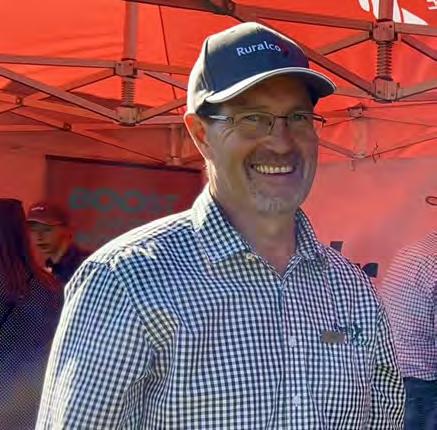
place to increase sales and profitability.
This was while increasing close connections with shareholders and listening to what they need from Ruralco to lower farming input costs.
“Achieving a trading profit of $175,000 for the 2025 financial year has been particularly pleasing as it indicates continued shareholder confidence in Ruralco,” says Aitken.
“We exist to deliver choice and real value through service, relationships, and savings that matter in Mid Canterbury’s highly competitive farm supplies market.
“We have continued a careful assessment of our cost structures, and made prudent, and at times difficult decisions.”
This resulted in reduced head count across the business, and the sale of Rakaia buildings.
Aitken says that while Ruralco has divested itself of the bricks and mortar at Rakaia, it is still very committed to the area, negotiating a long-term tenancy arrangement, recognising it plays a vital role in supporting shareholders in this area and the local community.
Debt reduction has also been a strong focus
over the last financial year, with the business taking a stronger stance on recovering bad debtors and putting processes in place to protect Ruralco from potential bad debt risk.
Resetting its strategy to be locally focused has been a positive move for the co-operative.
Over the last 12 months it has created multiple opportunities to connect with shareholders including local A & P Shows, an inaugural golf classic to support the Mid Canterbury Rural Support Trust, the Spend for Your School initiative which gives back to local primary schools, Ladies Night (again partnering with Mid Canterbury Rural Support Trust), and Ruralco’s flagship event, Instore Days which again attracted over 2200 attendees.
“Ruralco holds a unique place in Mid Canterbury’s farming landscape,” says Aitken.
“It is New Zealand’s only regional, farmerowned co-operative dedicated to lowering input costs for local farmers and we are committed to continuing to support a thriving future for our rural community.”
@rural_news
facebook.com/ruralnews
Aitken says it’s great to see such a strong line-up of candidates wanting to join the Ruralco board.
He says this is a vote of confidence in what they are doing, and another indicator of the increased support they are seeing from shareholders.
“It is important people engage in the voting process, and we encourage as many shareholders as possible to vote and exercise their right to have their say,” he says.
Ruralco CEO Tony Aitken
Expo scales to new heights
ENGAGING, THOUGHT provoking speakers, relevant seminars and relatable topics alongside innovative products and services are the order of the day at the 2026 East Coast Farming Expo.
The boutique sheep and beef gathering –being held on February 18-19, 2026, at the Wairoa Racecourse – has become a firm favourite on the rural calendar for many.
It’s a place to learn, try, buy and connect.
Event manager Sue Wilson says it was the perfect spot to network, delve into agribusiness and talk all things farming.
The seminar programme is packed with talent, including the Prime Minister’s chief science advisor
Dr John Roche, Ray Leach on Whangara Farms 100-year Whenua Optimisation Plan – He Rau Ake Ake, renowned agribusiness accountant
Pita Alexander, former Ahuwhenua Young Māori Farmer of the Year Chloe Butcher Herries and others.
The Property Brokers Evening Muster on Wednesday is always hugely popular as are the cadet and station challenges.
For event director
David Martin, it made perfect sense to create an expo specifically for East Coast sheep and beef farmers. He came up with the idea when driving the tractor – he’s the first to admit it’s where he does his best thinking.
“Field days were never at the right time
for our business, and I was sick of heaps of non-sheep and beefrelated stuff,” he says.
Add to that the vast numbers of people at the event which meant long wait times to see stretched sales teams.
“I thought, ‘gee, wouldn’t it be great to bring them to me. What if we do that in Wairoa?”
So began the plan to create a sheep and beefspecific event, designed to attract just the right people.
That was 10 years ago and since then the event has grown in leaps and bounds. The goal has always been to help sheep and beef farmers connect with service and product providers in the easiest and most relaxed way they can.
“It’s designed to be a low-stress
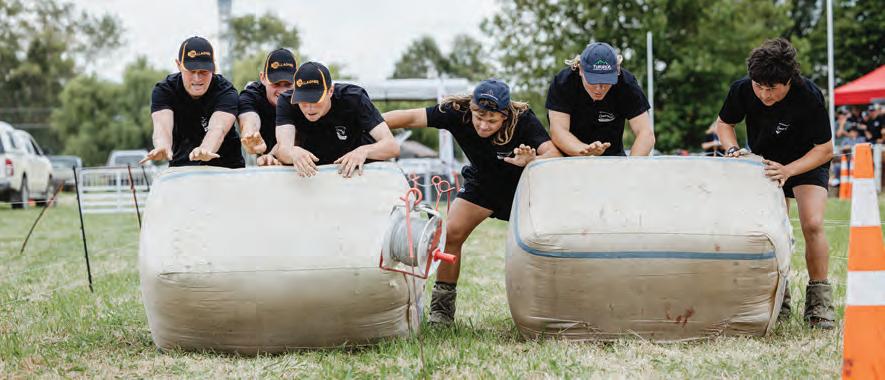
environment,” says Martin. “A lot of singleoperator businesses don’t have time to attend every display day. Our mid-week event enables farmers to get a few jobs done in the morning, attend the Expo, talk to a few exhibitors, catch a seminar or two, see a mate and still get home at a decent time to feed the animals.”
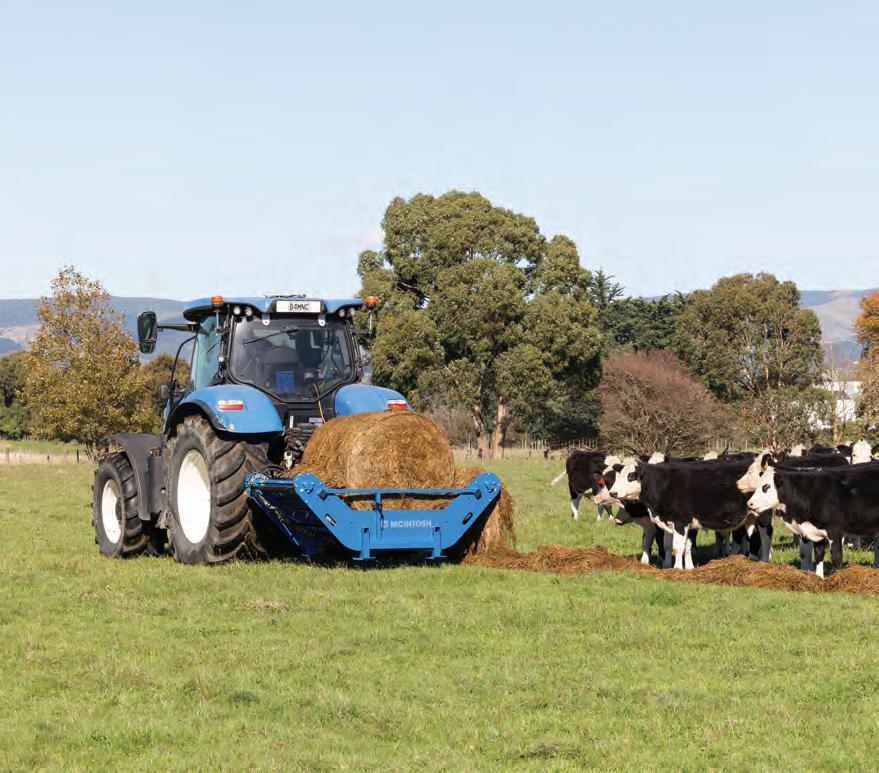


In a nutshell, it’s minimal time off the farm for maximum impact.
“There are huge benefits for farmers to talk to innovators and salespeople, and see and touch the product they are selling, or learn about a service.”
For exhibitors, it opened the doors of
opportunity at minimal cost. “Farmers and teams are there for genuine reasons and looking for products or services to help their


The Beef+Lamb NZ station challengeTukemokihi and Hereheretautau go head-to-head.
It’s drench resistance, not a death sentence
DRENCH RESISTANCE is already hitting farm profits; it’s not just a future problem.
At a recent Beef + Lamb NZ field day, Wairarapa farmers showed it doesn’t have to be the end of the road. With the right support, knowledge and confidence, farmers can stay ahead of resistance and keep stock performing.
The event featured members of the Wairarapa Livestock Parasite Management Group, a collaboration between B+LNZ and local vet and parasite expert Sara Sutherland. Farmers in the group shared their experiences managing drench resistance and offered practical advice for others facing similar challenges.
The panel outlined a range of strategies to tackle resistance, starting with monitoring, then moving through prevention, stock integration and ensuring drench is not the first solution
reached for.
“You’re farming worms,” one farmer said. “Once you figure out your worms, then you farm accordingly.”
Many farmers don’t realise resistance is an issue until it’s already causing problems. That’s why monitoring is essential. The group encouraged others to begin with faecal egg counts and drench effectiveness tests, and where possible, identify worm larvae species.
As Sara Sutherland put it, “Test, not guess.”
Monitoring livestock condition was another key focus. Speakers highlighted the importance of ewe condition, noting that well-fed ewes often don’t need routine drenching. Healthy ewes also produce heavier lambs at weaning, allowing lambs to be sold or moved off the farm earlier. This reduces worm pressure and improves overall farm health.

is no recipe for perfect parasite management on every farm,” she said.
“Starting with the basics – good feed, parasite monitoring and minimising the
time lambs are on grass – can make a big difference.”
Other strategies discussed included reducing the number of young animals on farm, identifying blocks with high and low contamination, using mature animals or cattle to clean up pastures and maintaining refugia (a way preserving drench susceptible parasites). Attendees also learnt about DAGI (Drench and Grazing Integration), a new app being developed with B+LNZ support to help farmers map contamination levels across paddocks.
Genetics was briefly mentioned but recognised as an important long-term part of the solution.
By following these approaches, farmers can reduce their reliance on drench. Reflecting on past practices, one panellist said, “These days we don’t put a drench into any ewe, we
don’t put a capsule into our hoggets... We’re living in a new world now where that’s just not an option if we want to carry on and hand the farm over to the next generation as a viable business.”
The takeaway from the field day was clear. Prevention is ideal, but practical management can make a real difference.
Looking ahead, B+LNZ’s parasite research programme is focused on developing new diagnostic tools and supporting changes to farm systems. Awanui Veterinary is currently working on a new tool that will provide more detailed information about parasite species faster for decision making. Following the success of the Wairarapa group, seven parasite management groups have now been set up across the country, if you want to find out more talk to your local extension manager. • Article - B+LNZ
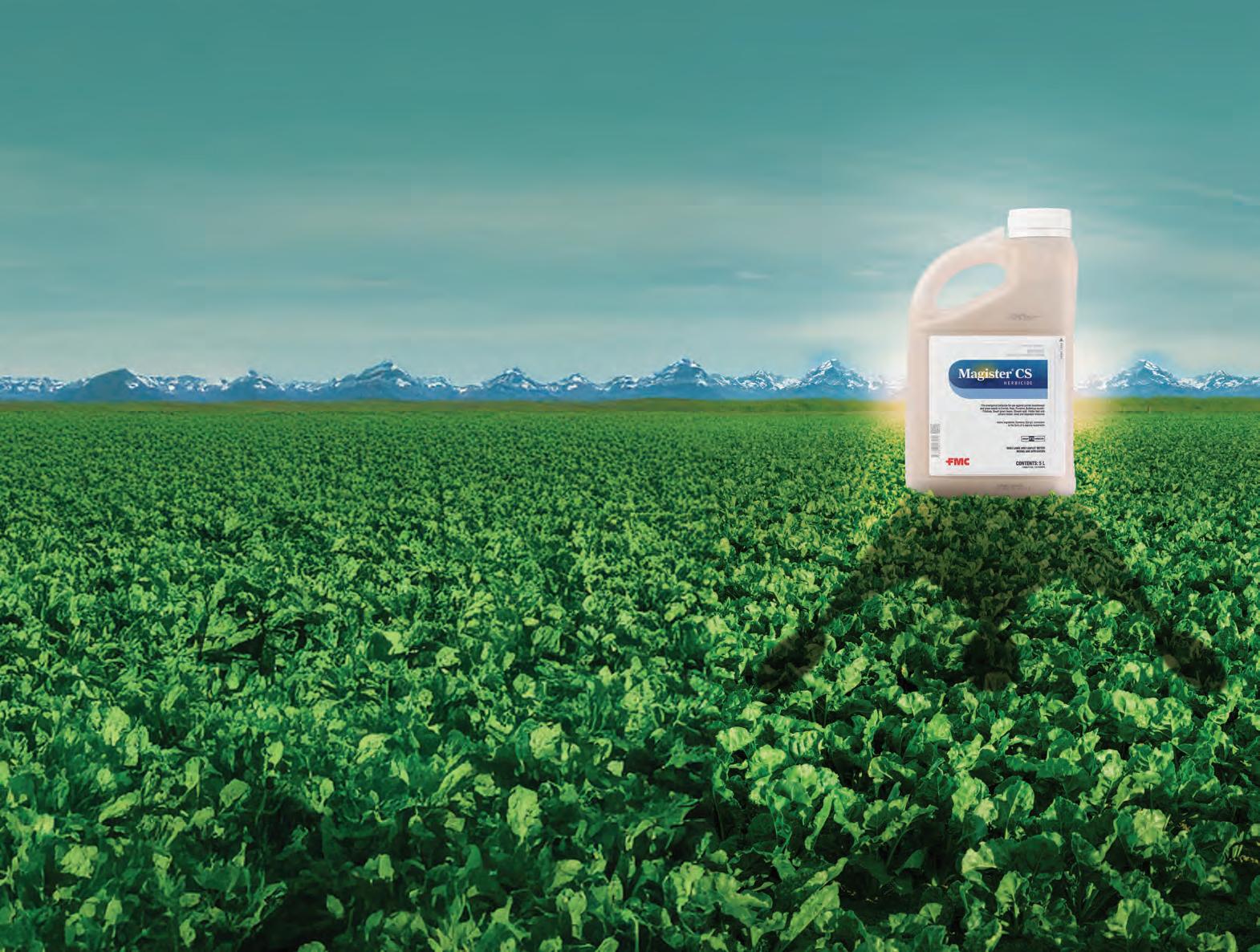

Wormwise programme manager
Ginny Dodunski reminded farmers there is no universal solution. “There
B+LNZ wormwise programme manager Ginny Dodunski.
Simplifying ram selection
WITH RAM buying season underway, B+LNZ is encouraging farmers to take advantage of its free online tool, nProve, to help them find the rams that best meet their breeding goals.
Developed by B+LNZ with input from farmers, breeders and rural professionals, nProve was designed with a clear purpose: to make it easier for farmers to harness the power of genetics and make more profitable breeding decisions.
Sarah Powdrell, B+LNZ’s genetics extension and operations manager, says ram selection can be likened to buying a car.
“Most cars share similar features, but people still have preferences - some might choose a particular colour or brand, while others opt for electric or hybrid models for efficiency or environmental
reasons. Rams are no different. While they may look similar, their genetic makeup can vary significantly.”
All cars in New Zealand also have safety test ratings. You can compare most models on the same scale and rank them from poorest to best. While these ratings don’t tell you everything about a car, they do a good job of assessing something that’s otherwise hard to evaluate without a degree in engineering and a lot of fancy equipment.
Just as cars have safety ratings, rams can also be objectively compared using genetic indexes and breeding values. These provide insights that go beyond what the eye can see. nProve presents this information in an easyto-use format, allowing farmers to make objective comparisons.
“Eye appraisal alone
doesn’t cut the mustard compared to ratings based on comprehensive data on an animal and its family members,” says Sarah. “There needs to be a balance, and that’s where nProve comes in.”
Using a series of sliders and filters, farmers can identify and prioritise traits that are important to them, and the tool will identify breeders that align with those preferences.
“For example, if facial eczema or parasite resistance are important traits to you, move these sliders to see the top flocks for those traits.”
Sarah acknowledges the challenge of juggling lots of figures for a range of traits on sale day, especially with the addition of new traits as science emerges.
“We’re often told by farmers that ram buying is getting more complicated. That’s
why we built nProveto simplify the process and empower farmers to have more effective conversations with their ram breeders, both before and on sale day.”
She recommends farmers have a play with the tool which is available at nprove.nz, ahead of their ram purchases.
“As you move the sliders, nProve identifies your options nationwide, which can then be narrowed down by region, breed, and birth year,” Sarah explains. “You can even flag breeders or rams of interest and create a shortlist. When you’re ready to contact a breeder, their details are easily found by clicking the ‘More Info’ button.”

Breeders put a lot of effort into breeding the right rams for their clients and welcome the opportunity to talk through their breeding philosophy and the data that backs up the merit of their rams. Tools like nProve help ensure those rams are matched with the right farmers, creating better outcomes for everyone.
TACKLING SALMONELLA ON DAIRY FARMS
SALMONELLOSIS IS a serious disease in cattle.
According to Ministry for Primary Industries (MPI), in dairy herds it can trigger severe outbreaks of scouring, abortions, or sudden deaths, with a devastating economic impact and a lasting knock-on effect on the farm.
Salmonella also poses a risk to people working with stock, including farmers and vets. And when antibiotics are needed
to manage outbreaks, it adds pressure on antibiotic use, another concern for animal and public health alike.
MPI continuously monitors Salmonella in cattle. Since spring 2024, the number of diagnosed cases has been higher than usual, and this increase has continued into spring 2025.
To date, the number of labconfirmed cases in 2025 is already twice the total recorded
in 2023, and the dairy season is only halfway through (see figure 1). A previous national outbreak occurred between 2017 and 2020, but the number of cases recorded this year has already surpassed the epidemic levels of 2019-2020.
MPI is investigating what drives Salmonella outbreaks on farms - and what helps prevent them.
“We’re inviting all dairy farmers - whether or not you
have experienced Salmonella on your farm - to take part in this phone survey. Your input can help protect herds and support practical solutions to decrease the impact of Salmonella in dairy. The phone survey is short and confidential,” it says.
• People can get involved in two easy ways. Completing the contact form online at; www.mpi.govt.nz/mpi-salmonella or by emailing their local MPI On-Farm Support team.


Bigger and better Wool Zone
CANTERBURY A&P Association (CAPA) show president Brent Chamberlain says a big development for this year is the Wool Zone, first introduced two years ago as a showplace for everything produced from wool, but now greatly enlarged with its own Wool Marquee and more than 30 trade sites.
A fashion parade of wool-based garments will run in the shearing pavilion at lunch time, on both Friday and Saturday.
A Grand Parade will take place both Friday and Saturday and all of the youth competitions will be on Saturday morning.
Most of the regular attractions are back,
including sheep dog trials, pipe bands, Shetland pony races, a Clydesdale display, showjumping, the City Farmyard and Rare Breeds.
The Wood Chopping will feature a South Island versus New South Wales test match, held across all three days. New for this year is a Cowboy Challenge competition for horse and rider completing a series of tasks, to be held indoors along with a farrier competition in the Riding for the Disabled building at the south end of the main ring.
For A&P Association members there will be cocktail party on the Friday night which Chamberlain hopes will encourage new or renewing members
after numbers “drifted off a bit” in recent years. There has been a pleasing lift in membership numbers this year.
Brent’s involvement with the Canterbury show began when he helped show cattle for his then employer in 1978.
“Membership is not just about getting free tickets to the show. It’s about supporting this iconic Cup and Show Week show for the future,” he says.
“We need to keep this
See us at Canty Show site Wool Zone 33

Heiniger

Because we care about
show going for future generations through the next hundred and something years.”
Both Brent Chamberlain and his wife Wendy come from farming families with long histories with the A&P movement, Wendy having been a recent president of their local Courtenay Show at Kirwee.
Brent’s involvement with the Canterbury show began when he helped show cattle for his then employer in 1978. He progressed to head steward of the cattle section for many years, then chaired the sheep section. He was elected to the general committee about 15 years ago.
“I’m the fourth
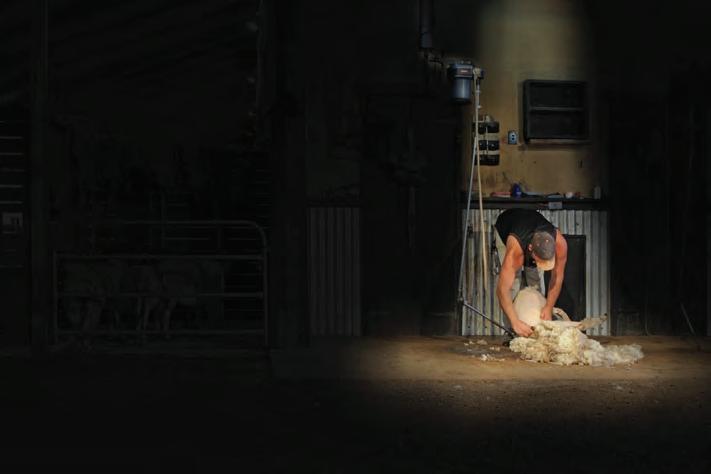

the new indicator with audible and visible alarms that let you know when you’re approaching the target weight.
Watch our equipment in action!


Chamberlain president in 160 years of the Canterbury A&P Show. We’re all related.”
With a background in animal health for both Novartis Animal Health and Ravensdown, Chamberlain is now an On Farm Account Manager for the Mid Canterbury-based farmer owned co-op Ruralco and he appreciates their support during his role as President.
He runs about 60 Dohne ewes, a South African Merino breed, on their 10 acre home block near Darfield, selling the lambs as hoggets, and also grazes a number of other 10 acre blocks in the area.
“So that keeps my hand in farming,” says Chamberlain.
THE RACE IS ON
THE SHIFT to a Thursday-FridaySaturday show potentially creates a clash with another of the traditional major events of the Canterbury Cup and Show Week calendar, the New Zealand Cup gallops meeting at Riccarton.

couple both enter items such as Christmas cakes and preserves in various shows, and
surroundings and the chlorinated town supply water, and while there they need 24-hour supervision and milking.
probably end up taking about eight or ten.
He hopes the clash of the two events does not affect each other’s attendance too much as they probably attract different groups of people.



The

A show stalwart, Tai Tapu champion Holstein Friesian breeder Dean Geddes, did not support the change, partly because for him the races are his day off.
While he can take them a day later this year, it also means they have to stay a day later and he will have to get someone else to manage them on the Saturday.
“I’m still going to the races on Saturday,” he said.
Asked if the exhibitors are generally supportive of the new timetable, Chamberlain said the entry numbers “tell us a good story.”


Shearing Plant
The show is a big commitment for Geddes as he takes his animals to the showgrounds about three days early, to get them acclimatised to their
“It’s my only day out for the year. I enjoy it after being so busy for so long.”
Geddes says he has about 18 animals entered for the show but will
“It is change. But at this stage we’ve gone for the three days, and the general committee are supportive of it. So, we’ll just get in behind and make it happen.”
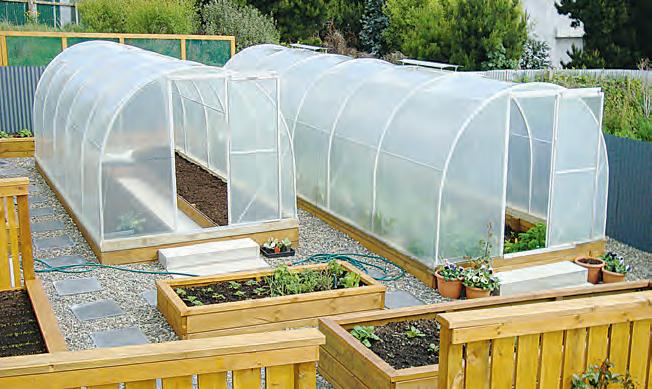

Backease Hoist


See us at Canty Show Site F16


The
Chamberlain intends to show four of his merino fleeces at the Canterbury Show.
Canterbury A&P Association (CAPA) show president Brent Chamberlain.
Hot Saw redemption for new world champ
DANIEL
GOING ONE better than a frustratingly close second place finish at last year’s event, the country’s top axeman, Jack Jordan of Taumarunui, last weekend won the Stihl Timbersports World Championship individual event in.
Jordan was jostling for the top spot in a 12-strong field, battling with legendary Australian Brayden Meyer right up until the last of six disciplines, the volatile, super-powered Hot Saw.
Falling at this hurdle last year, this time Jordan calmed his nerves and the high-powered machine to record a personal best time of 6.30 seconds and win his first individual world championship crown.
It was the 28-year-old King Country farmer’s third appearance at an individual World Championship
– the more traditional, long-form format across six different disciplines, compared to the faster, four-discipline format STIHL Timbersports World Trophy competition that Jordan had won three consecutive times.
Jordan joins the illustrious company of Jason Wynyard and David Bolstad as the only other Kiwi to ever win the coveted Timbersports World Championship individual title. Jordan finished the competition just four points ahead of Meyer with Poland’s Szymon Groenwald third.
“It was tough dog fight all day, but I knew it was going to be. Leading up to the competition, I didn’t train too much on the chopping events, but instead focused on my weaker events, which were the three events that I won today, confirming that the targeted training paid off, and I came away with the gold!” says Jordan.
Jordan was the sole New Zealand

representative in the individual competition, after he topped a 10-strong field at the NZ National STIHL Timbersports finals in March this year.
The New Zealand team of Jordan, Cleveland Cherry, Quintin Fawcett and Chris Lord finished just out of the medals in fourth place, in a 15-strong field, the day before the individual
To Give A ‘Better Use Of Water’
We connect your water meter data with climate, soil moisture to give a real basis to irrigate or use water with:
• The right amount
• At the right time
• Tailored Presentation
• Real Time Data
• Action Alerts
• Mobile Friendly

Stock Water Management • Tank level – Axroma
Systems for clean water
Clients use us because
• Good Value... cost effective data
• Easy setup and easy to use
competition. Australia, Sweden and Poland finished first, second, and third positions respectively, with the Chopperoos taking a seventh consecutive team victory.
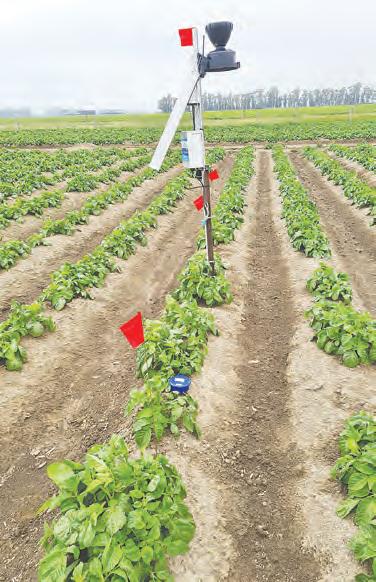
• Uncomplicated presentation giving simple farm management decisions
• Nationwide service and backup
• We are well established being the leading provider of water measuring systems
• Equipment is reliable land well proven to perform
• We support you in your audit and environmental reporting

Jack Jordan on the Hot Saw.
Contractor opts for Optums
MARK DANIEL markd@ruralnews.co.nz
HAVING WORKED as a diesel mechanic, often on Case IH machinery, Brian Hughes was familiar with the agricultural industry and looking around the Invercargill region where he was based, saw an opportunity for contracting in the sector.
In 1986, a change in direction saw Hughes Contracting established with one Case IH tractor. Fourty years later the business is still going strong, with a staff of around fifty and a fleet of thirty tractors. It also runs a host of other equipment including trucks, excavators, harvesters, balers and loaders.
Hughes Contracting is one of the larger agricultural contracting businesses in Southland, with depots at Waimatua and Browns, providing a range of services including cultivation, planting and harvesting baleage and silage, providing feed supplies, cartage and excavating and all types of effluent disposal.
With Brian’s son Chris now at the helm, the operation has recently taken delivery of two new Case IH Optum
300s to complement other Optums and Pumas in the fleet. Having used Case IH tractors since Brian started his business, the brand has delivered the performance and reliability that their busy operation requires, while also helping establish an enduring relationship with local dealer, Agricentre South, in Invercargill.
“The Optums are such a versatile tractor and although we had used bigger models previously, the Optums have enough power to manage all our heavier tasks while still being flexible enough to manage everything else we need. The new duo will predominately be used for grass mowing with 10m mowers, so there’s plenty of work ahead of them,” says Brian.
After a favourable winter for agriculture in his region, they we’re looking forward to a good season ahead, meaning the new tractors should soon be earning their keep.
In the 40 years the business has been running, Brian has had a frontrow seat to the evolution of agricultural machinery, so he and Chris welcome the benefits the increasingly sophisticated technology of today provides.
“There’s been big changes with the
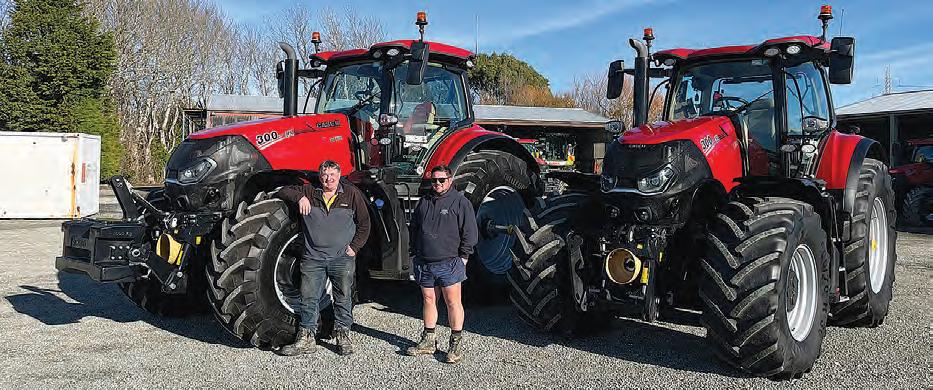
tractors over the years, so it’s hard to see where they’re going next. Every time a new one arrives, we say, ‘how are they going to improve on this?’ but they always do,” Brian says.
“Over the years, the improvements that stand out for me, are the standard of the cabs, particularly the levels of comfort and noise, for operators who work long hours. We have also seen huge improvements in efficiency with things like the arrival of CVT transmissions delivering improved fuel economy, which is a big thing for operations like ours, where you’re
running so much machinery at any one time.”
Precision agriculture features are also rated highly by Chris, who credits the likes of GPS optimisation and guidance with greater accuracy and fuel savings. Currently, around half of the tractor fleet now runs AccuGuide to provide hands-free automated steering.
Dealer Agricentre is also working with the business on greater traceability and insights around the tractor fleet, currently in the process of connecting the entire fleet to Case IH FieldOps. This seamlessly connects
and integrates agronomic insights and machine performance data, providing users with a comprehensive overview of their operations and fleet, from anywhere with a mobile or Wi-Fi connection.
Richard Clapperton of Agricentre South says this will provide the business with real-time machine location, machine parameters, alongside provide proof of placement for fertiliser and slurry application. “Their fleet will also be visible to Agricentre, giving us the ability to plan scheduled servicing as well as monitoring tractor alerts.”


Brian and Chris Hughes with their two new Case IH Optum 300s.
Fieldays hold out the begging bowl
WHEN SOMEONE says “we don’t want a handout, we need a hand up” it usually means they have both palms out and they want your money.
Such is the case with National Fieldays who in early October headed to the Beehive, to, as they put it, “highlight the need for strategic investment in the future of Fieldays”, to evolve the campus to be truly fit for purpose.
Looking for an annual “hand up” of $5 million – that’s right, $5m – the investment would offer long term value, industry sustainability and iwi partnerships, ideally in a partnership model with government.
Citing an Economic Impact Report carried out by Waikato University, they suggested that Fieldays makes a $500 million contribution to New Zealand’s economy. Of course, economic impact surveys are used to justify all sorts of investments, usually achieving an accuracy of less than 50%. Indeed, let’s not forget an impact assessment that told us how much benefit bringing the V8 Supercars to Hamilton would create.
One also has to question such an assessment when back to 2020, Fieldays was cancelled because of Covid-19, yet the Tractor and Machinery Association reported that tractor and machinery sales were up by over 35% that year. Go figure?
Going back to that potential $5m handout, Fieldays’ business model, is about renting out plots of grass or concrete, providing toilets and car parking, then charging exhibitors and the public, a lump sum investment for a family day out.
Casting an eye over the Society’s 2024 accounts throws up some interesting numbers, with the key metrics a turnover of $10.91m and operating expenses of $10.38m. Within those expenses, we see “other overheads” of $1.34m, property expenses of $755,000 (that’s a lot of paint for the toilet blocks) and a rather large sum of $3.38

tools sold on the day, but large capital equipment?
If they really think that a contractor buys a $400k tractor out of the blue, they need to remember line from the iconic Aussie movie The Castle: “tell ‘em they’re
million spent on wages, for around 32 full-time Fieldays and Mystery Creek staff.
Digging deeper, we also see that the four members of the Key Leadership Team were paid $931,000 in wages and benefits, up nearly $100,000 over the previous year.
Looking back to the Impact Report, they, rather laughably, sing their commitment to wellbeing, noting that they conducted 8094 safety inductions, which were compulsory before any staff were allowed onto sites during set up. No doubt they also clipped the ticket on sales of Hi-Viz vests along the way.
Gate entries saw 106,000 people passing through the turnstiles – just over twice the capacity of Eden Park, so is Fieldays really that important beyond being a rather large social event, confirmed by introducing lawnmower racing in 2025.
Having held such an event for 57 years, the leadership team probably needs to take a lesson from their northern hemisphere cousins, who many years ago learnt that trying to be a Jack of All Trades is really a lost cause. Such events have largely disappeared, with the exception of the Royal Welsh and Highland Shows that have huge livestock competitions –something the organisers have previously told me that the animal rights campaigners wouldn’t like.
Fieldays need to take a lesson in not believing their own marketing hype about the amount of business being done on-site. Of course, there will be lots of gumboots, waterproofs and power
dreaming!”
Deals are done weeks, if not months, ahead of mid-June, typically with the need to discuss tradeins, finance and delivery dates. The facts are that Fieldays is largely out of date with how business
is conducted, with many exhibitors also realising that spending such a huge chunk of their annual marketing budget for four days doesn’t make sense, when there are another 236 working days in the year.
It’s worth remembering that the Fieldays event only happens because of the commitment and energy of the 1022 exhibitors and their staff,
Perhaps Fieldays has actually passed its use-by-
date and needs to ‘pivot’, like many businesses had to do post-Covid. It would be a much better look than holding out open hands, begging for a hand-out!
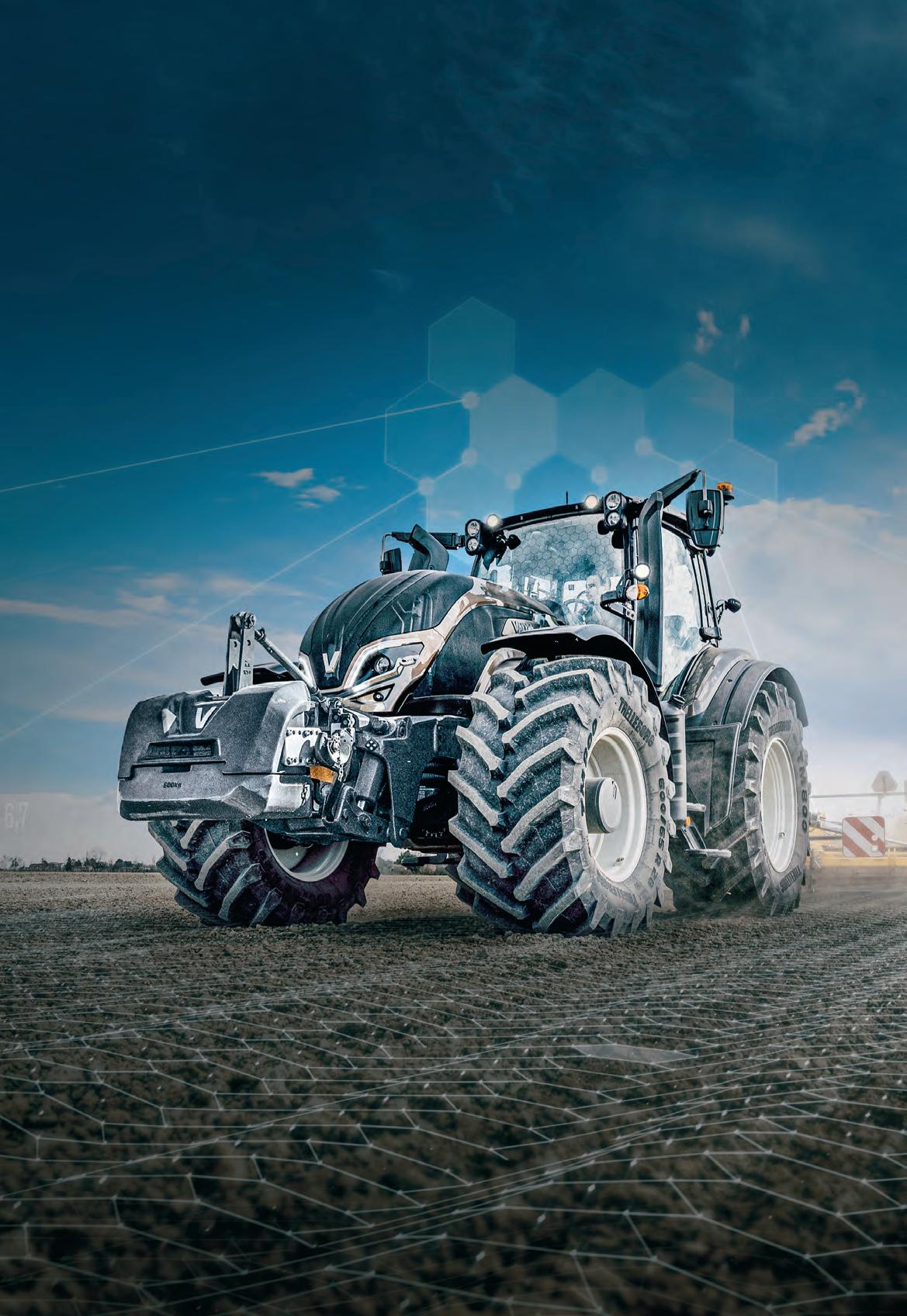
PERFECTION IN SIZE, POWER AND COMFORT
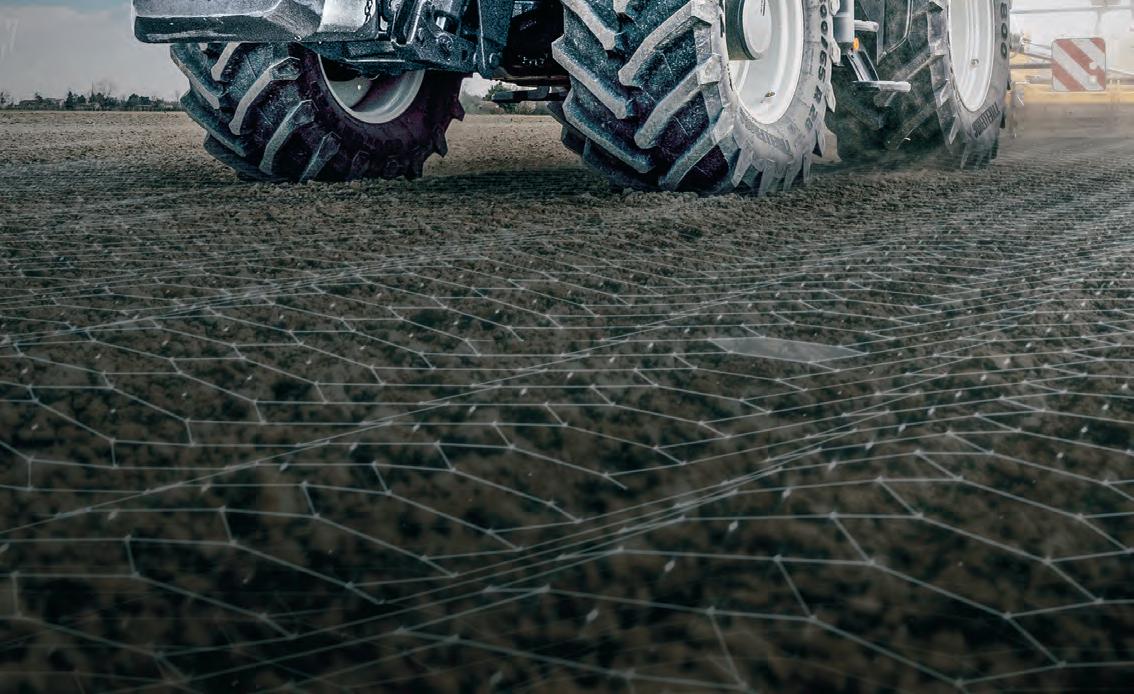
CRUSHA’S COMMENT Mark Daniel
Tractor market shows signs of recovery
DANIEL
MARK
markd@ruralnews.co.nz
AS WE move into the 2025/26 growing season, the Tractor and Machinery Association
(TAMA) reports that the third quarter results for the year to date is showing that the stagnated tractor market of the last 18 months is showing signs of recovery.
Year to date sales to September 30 reached total sales of 2153 tractors, a rise of 9% over last year’s 1975 units. Split between 1385 tractors in
the North Island and 768 in the South, the former grew by 9.7%, while the “mainland” was slightly softer at 7.7%.
Different regions were showing different
trends, with the Waikato region growing by 31.5%.
In contrast, Hawke’s Bay showed a decline of 30%. In the South Island, Marlborough and Mid-Canterbury both
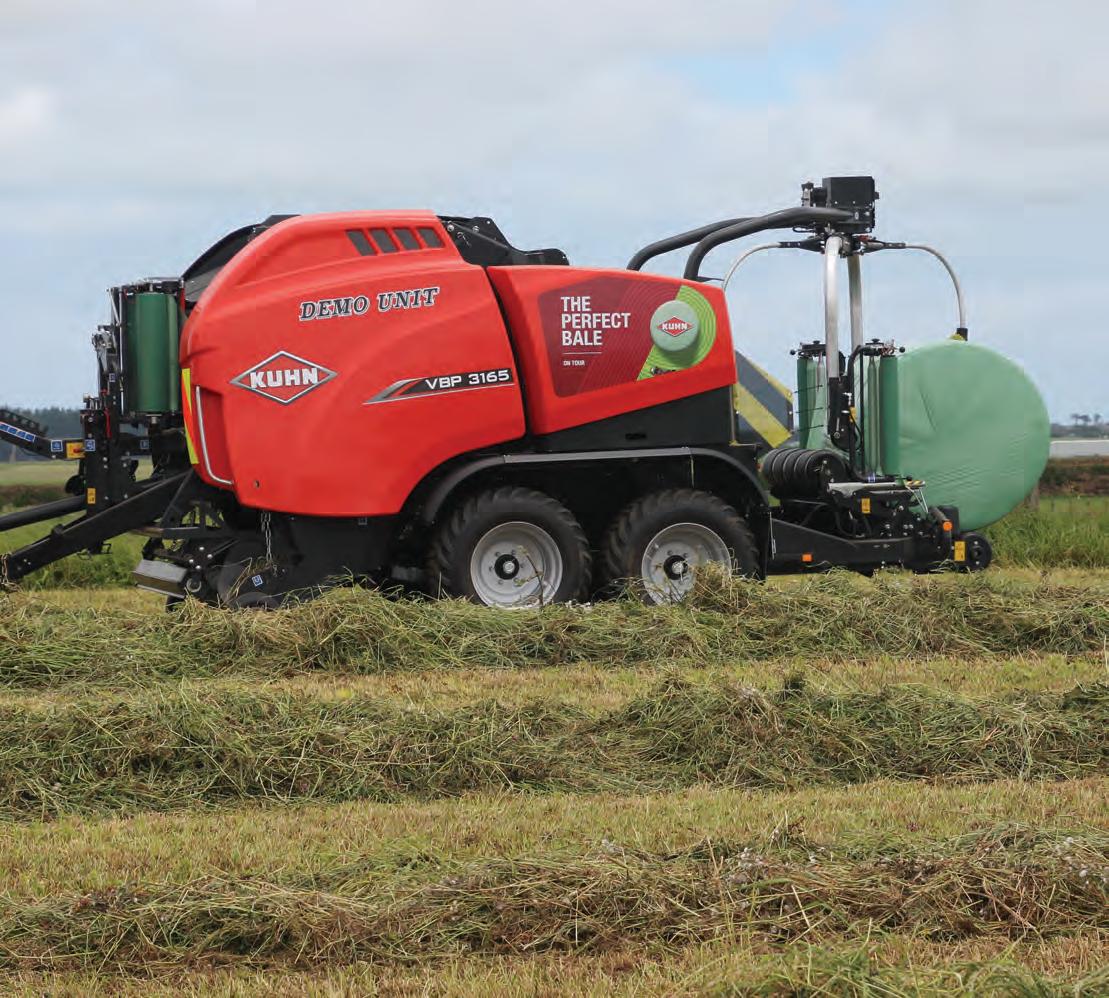
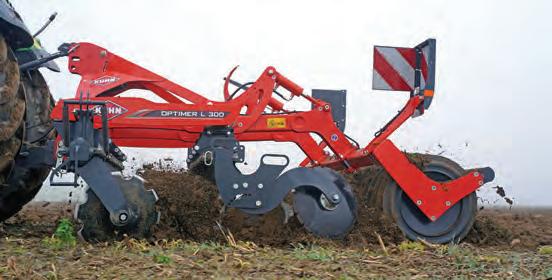


climbed by 33%, with the Southland tractor powerhouse only growing its market by 2.5%
Tractors sold over a wide range of horsepower, from 20 to over 375hp, with a wide range of variation. While the 70-80hp category recorded a YTD drop of 48%, the 100-120hp group climbed 14%, 120 to 140hp rose by 29% and the 180 to 250hp sector gained 23%. Meanwhile, at the higher end, over 375hp
tractors fell by 37%.
TAMA president Jaiden Drought commented, “with YTD numbers showing steady growth and the month of September showing a pleasing 18.4% gain, our recent dealer sentiment survey saw over 75% of farm machinery dealers expecting a significant lift in tractor and machinery sales over the next six months.”

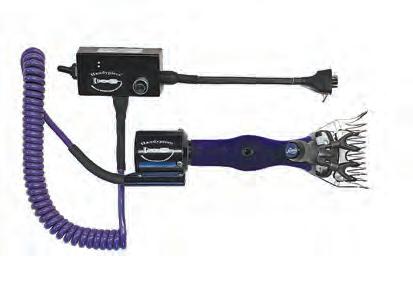


No chains on Krone CombiPack HDP
WELL-KNOWN FOR an extensive range of round balers, Krone’s new CombiPack HDP looks to have several features that sets it apart from its competitors.
It is not just the 41-knife chopping system, complemented by a gearbox drive system for the full-width belt variable chamber baler, with a complete absence of drive chains throughout, even for the pick-up. Indeed, the latter is powered hydraulically, with the configuration allowing the addition of an extra row of tines and increased width to 2.24m.
The pick-up can also automatically alter its rotational speed to match the forward speed of the tractor. The Hardox chopping rotor is also gearbox driven on the right-hand side of the
machine, allowing inputs of up to 340hp and an overall rating of up to 5000Nm. To help achieve an output of 40 bales per hour, the manufacturer recommends you need around 250hp ahead of the HDP.
The drawer/cassette for the chopping unit slides out laterally to the side of the machine for swapping out the 41 knives, with the option alternatively manually select five, 20 or 21 knives, if the theoretical 27mm chop - claimed to be the shortest in the market - is not required.
Krone suggests that the very short chop will help reduce mixing times and provide a more homogenous ration when bales are used in a diet feeder. Equipped with two binding units, both can be loaded with film and/or net.
To keep up the baling pace, a transfer kicker sends the completed bale to the wrapping table, where it
will be dealt with by twin-satellites spinning at up to 40rpm.
In other Krone news, the company has confirmed that it will temporarily suspend exports of its large forage harvesters and wide-area mowers to the United States, citing the growing impact of US steel derivative tariffs and the resulting increase in administrative and compliance costs.
Primarily affecting the flagship BiG X forage harvesters and BiG M Mo-Co’s, both series are aimed at high-acreage operations in the US corn belt and dairy regions. According to the company, the complex import certification procedures and unpredictable tariff assessments on steel-intensive machinery have made the current export framework economically unsustainable.
Krone will continue to deliver compact and mid-sized equipment

to North America, while it evaluates alternative strategies, such as local assembly or sourcing partnerships.
The pause also reflects a broader trend among European manufacturers facing
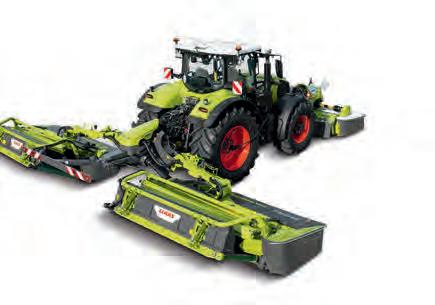
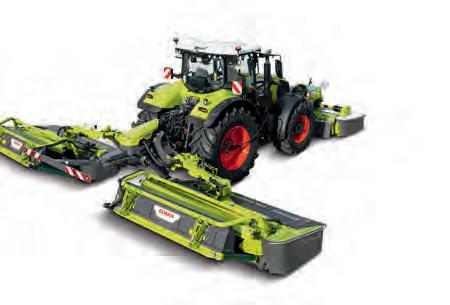
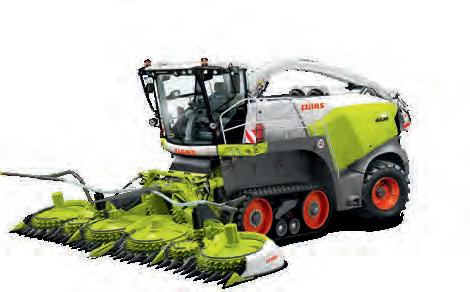
the dual challenge of trade barriers and logistical inflation,
Articulated tractor museum for charity
LOCATED IN York,
100km east of Perth in Western Australia, the Oliver Crane Memorial 4×4 Tractor Museum houses what is said to be the largest collection of articulated Steiger and International Harvester tractors in Australia.
The purpose-built museum is the result of a project dreamed up by Derrol and Sue Crane in honour of their late son Oliver, who in 2001 at the age of 17 passed away from a rare form of bone cancer.
In the ensuing years
since, Derrol has been busy collecting and refurbishing classic 4x4 tractors, with the museum currently housing around 40 Steiger and International tractors from 1970 to 1998, alongside a sprinkling of Case IH and Versatile examples.
Determined to raise A$100,000 per year for the next five years for bone cancer research, the family decided to turn the growing collection into a fund-raising purpose dedicated to their son.
Opened in early October, the museum will open periodically for public visits, with


SIMA DAYS NUMBERED?
WITH THE current situation in the European farm machinery market being described as difficult at best, it’s perhaps no surprise that the upcoming AgriSIMA 2026 agricultural machinery exhibition, scheduled for February 2026 at Paris-Nord Villepinte, has been cancelled.
The organisers report that a significant number of major manufacturers have decided not to participate, in turn undermining the economic viability of the event. The decision also reflects continued weakness across the French agricultural equipment sector, with sales not recovering to expected levels.
Additionally, a crowded trade-show calendar in France and the relative proximity to other major exhibitions, notably Agritechnica in November 2025, being held in Germany, contributed to the crisis of confidence among exhibitors. Sources tell Rural News that many manufacturers are increasingly struggling to justify high-cost static events which consume large percentages of their marketing budgets, when they can get more ‘bums on seats’ at targeted local working demonstrations.
The organisers are now said to be considering postponing the next event until 2027 or 2028, meaning another potential clash with the German Agritechnica or Italian EIMA events, while they reassess the event model, alongside seeking a stronger commitment from potential exhibitors before relaunching.
FIELD-READY VALUE YOU CAN COUNT ON
GET GEARED UP WITH CASE IH
Case IH is the trusted choice for mixed-farm enterprises to accomplish any task. We focus on what matters most: outstanding manoeuvrability, operator-friendly design, compact dimensions, and a high power-to-weight ratio for maximum productivity.
For a limited time, get a FREE RedXtend Total Protect warranty upgrade^ — available on selected Farmall, Maxxum, Puma and Optum tractors — that’s 3 years or 3,000 hours of total peace of mind. Plus, lock in low 0.99% P.A finance^ over 3 years across the whole range. Field-ready value you can count on.
For more information visit caseih.co.nz or visit your local Case IH dealer.

an entrance fee of A$25 (children under 12 free). All monies will go towards research via the Oliver Crane memorial bone cancer fund.
MARK DANIEL markd@ruralnews.co.nz
The Oliver Crane Memorial 4×4 Tractor Museum has the largest collection of articulated Steiger and International harvester tractors in Australia.
Stay Ahead of the Heat


HIGH PERFORMANCE
RESERVOIR
✔ Adjustable minimum & maximum on/off control
✔ Reduces pump wear with less on/off cycles
✔ Delivers up to 1275 L/min at 12 bar


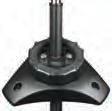

Reliable water solutions from pump to paddock


✔ Shows water level at a glance
✔ Protects system from water loss damage
✔ Fits any tank size or type








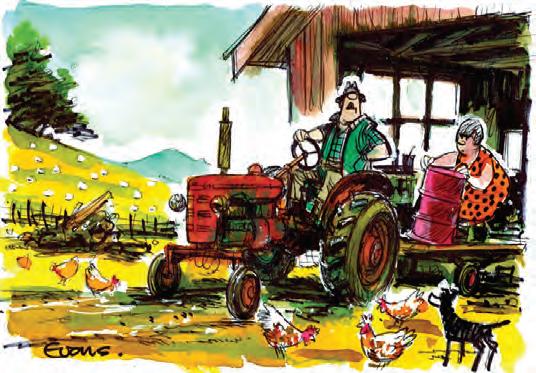








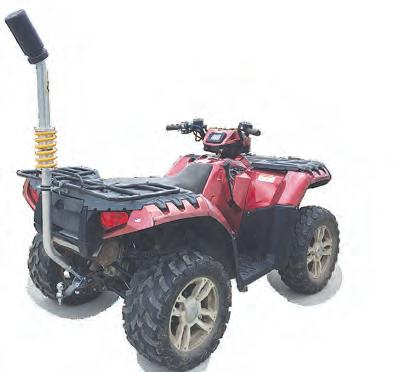




















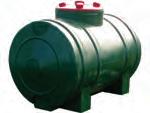

IT’D BE A CRIME NOT TO ENTER THIS COMPETITION.
How would you like to be in to win one of five of our Rural Crime Prevention Kits, as well as a $50 Bonfire Gift Card. T&Cs apply.
It’s super easy. Just scan the QR code below, then answer a simple ‘rural crime’ question and enter the draw. What could be easier?




We’re here for the good of the country.
Every year FMG supports over 1,000 families impacted by theft and burglary. Between 2020 and 2024 we paid out more than $32 million in burglary and theft claims – highlighting the scale and seriousness of rural crime across New Zealand.
Alarmingly, 1 in 5 of these clients at rural addresses have been targeted more than once in the same year.























Rural crime has been on the rise, making prevention and preparedness more critical than ever. As an advice-led insurer, we’re committed to helping our clients avoid the avoidable disruption, emotional stress and financial loss. We think now’s the time to put a lock on that trend!
To help you stay one step ahead of the criminals, we’ve joined forces with New Zealand Police to develop a helpful Rural Crime Prevention Checklist.
Just use the QR Code below to get your own copy. While these tips may seem simple, they are often overlooked and contribute to common claims we see daily.

